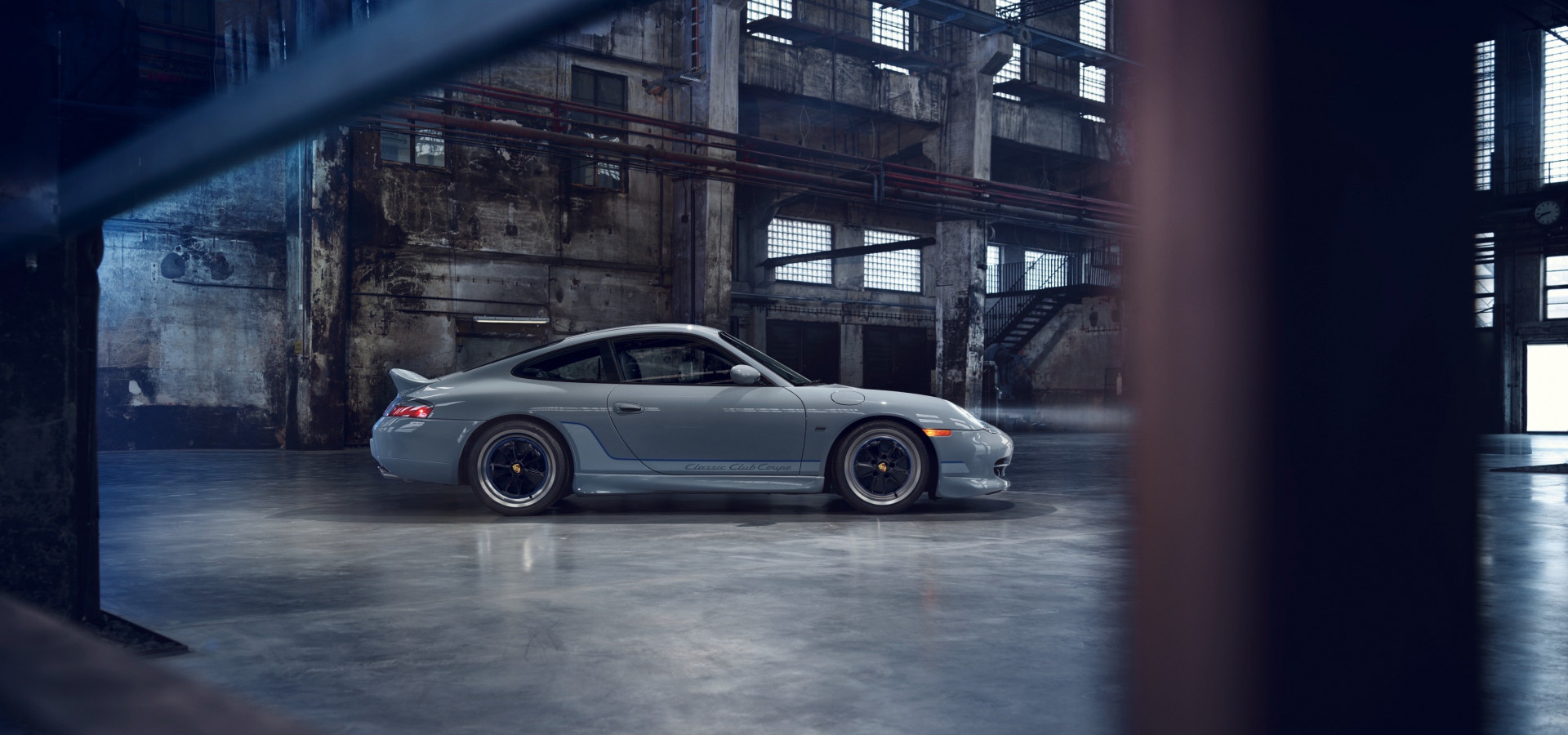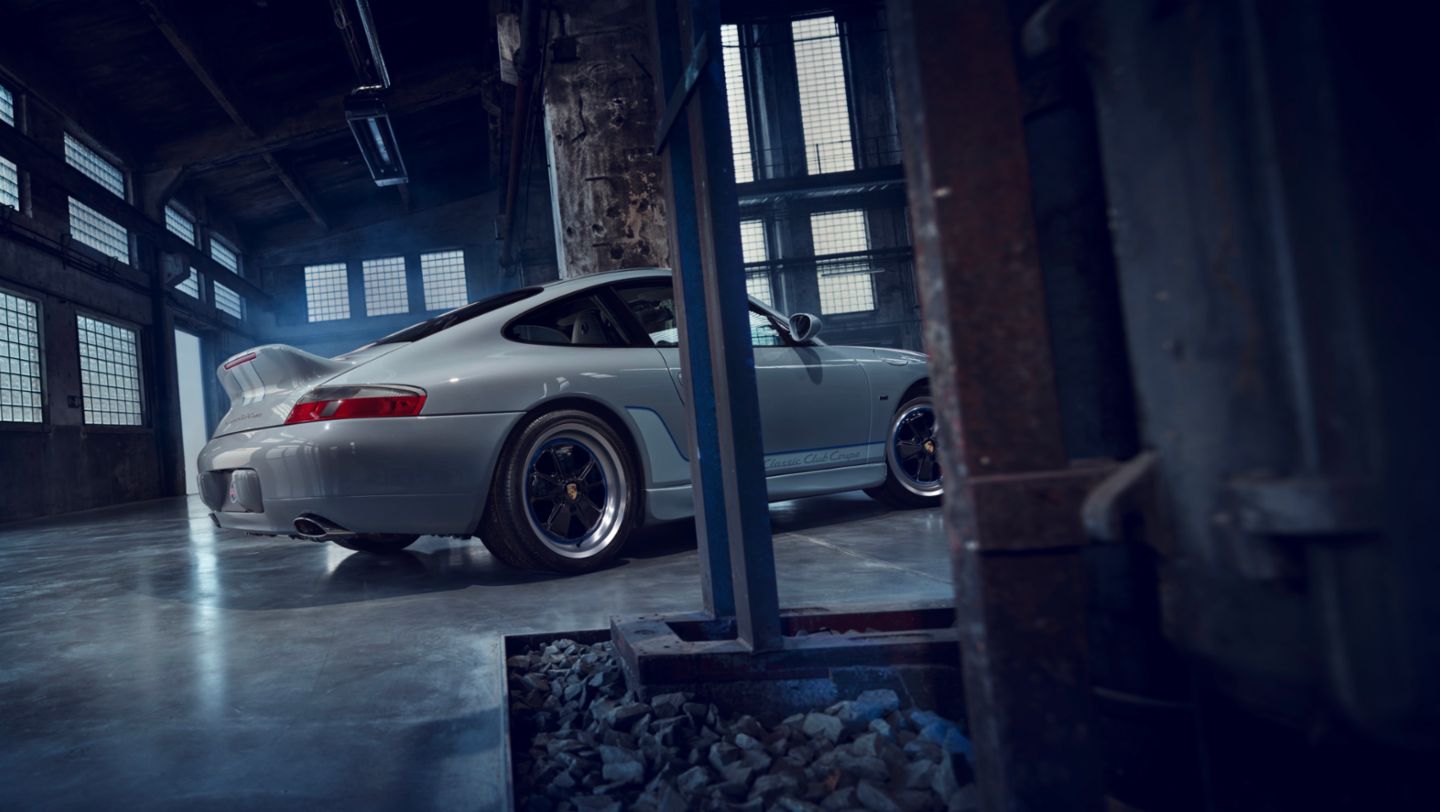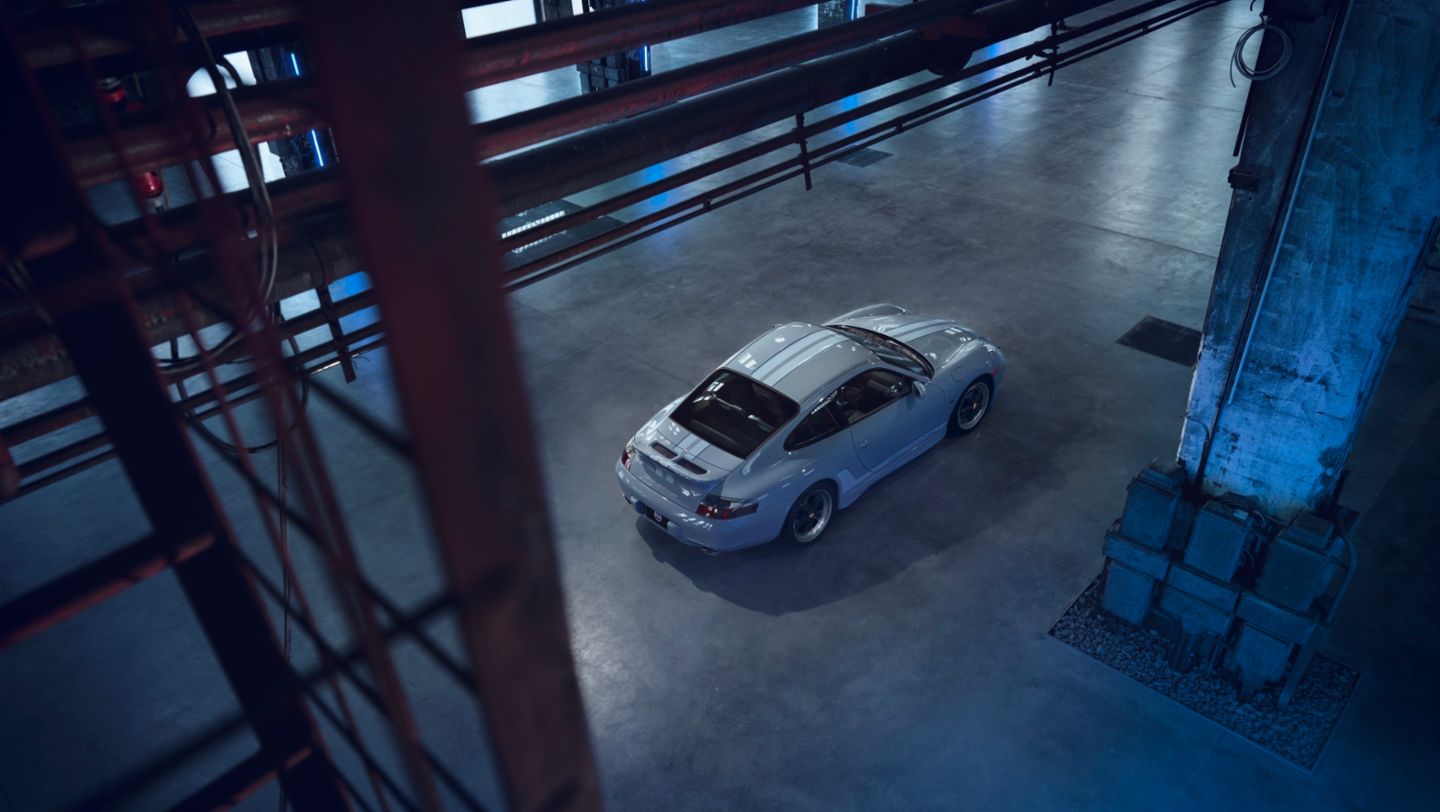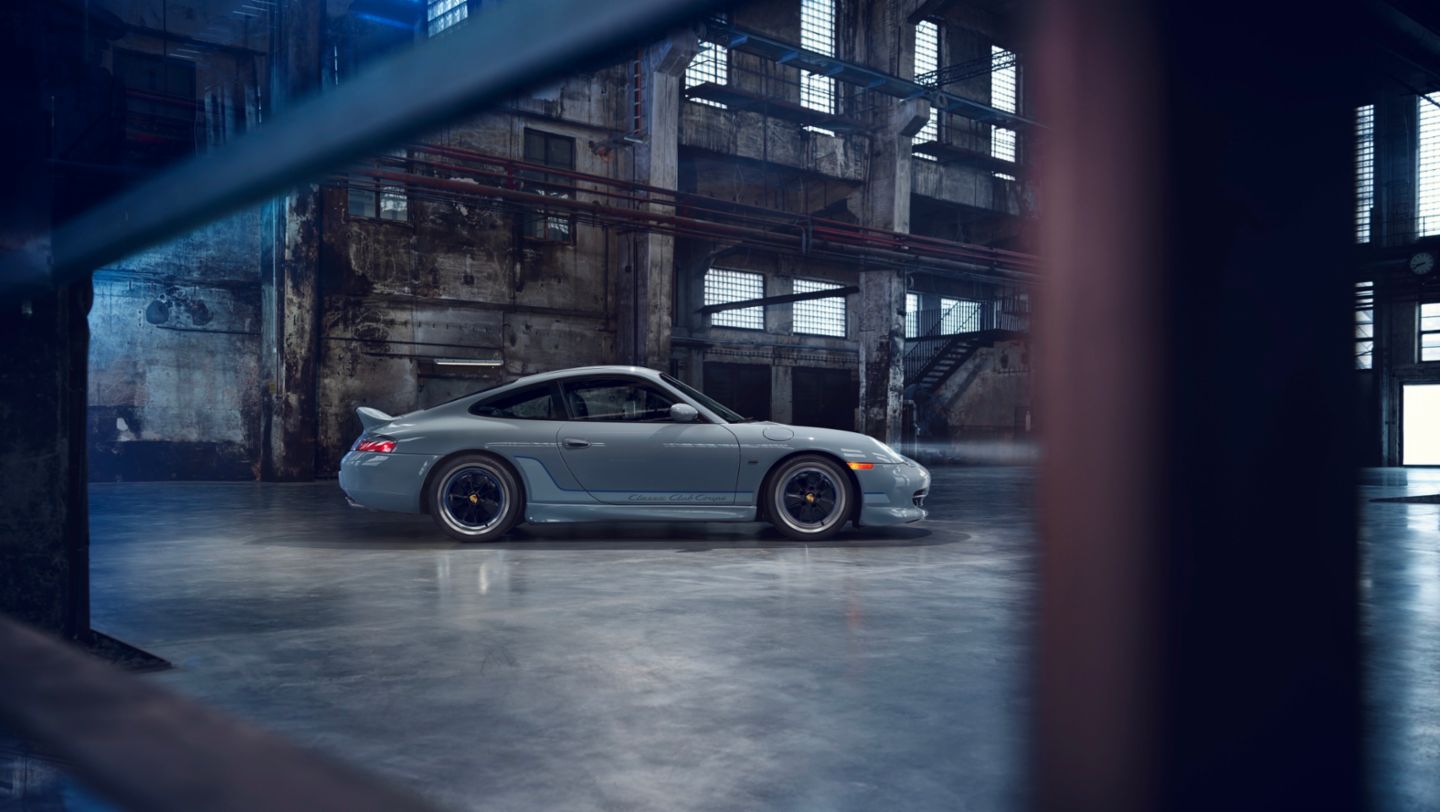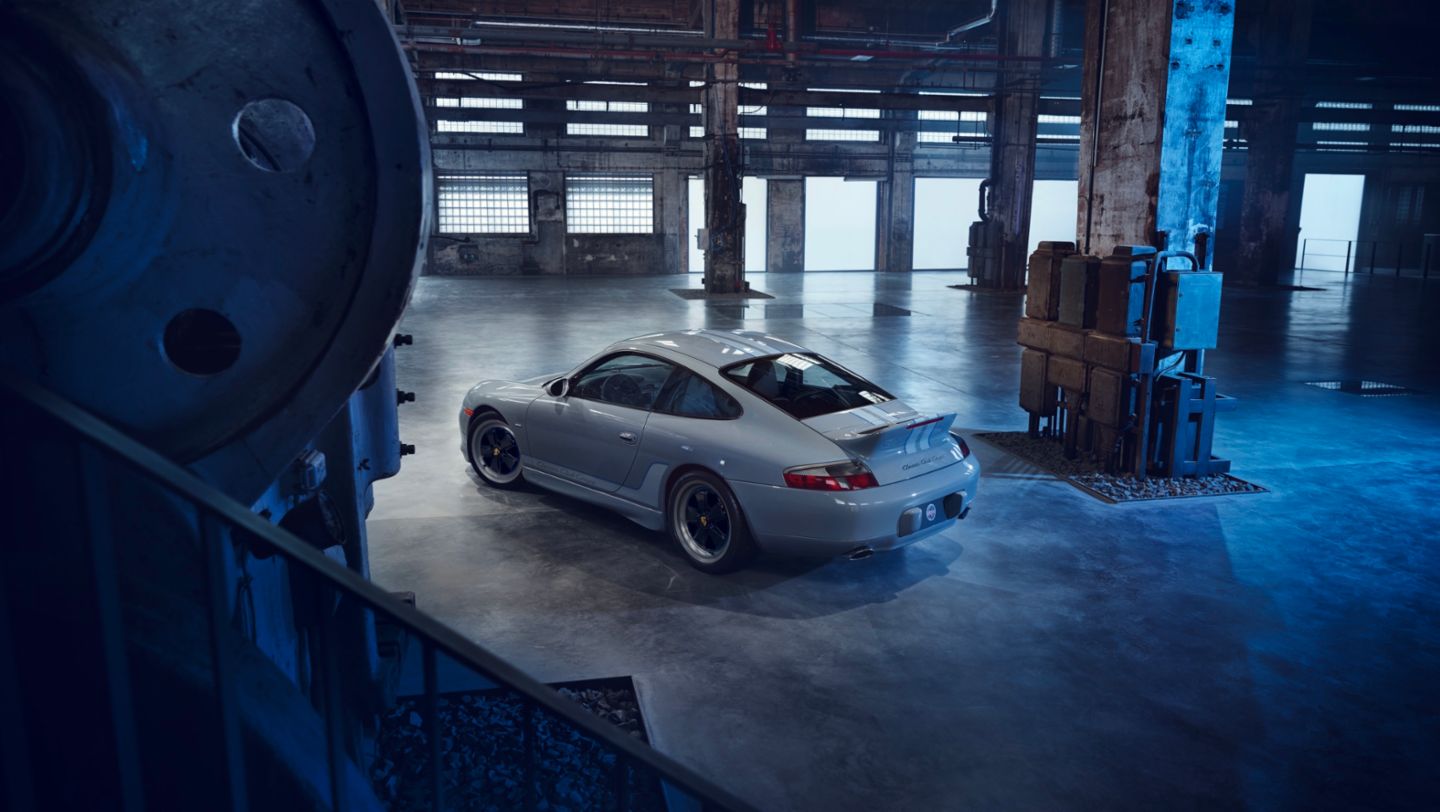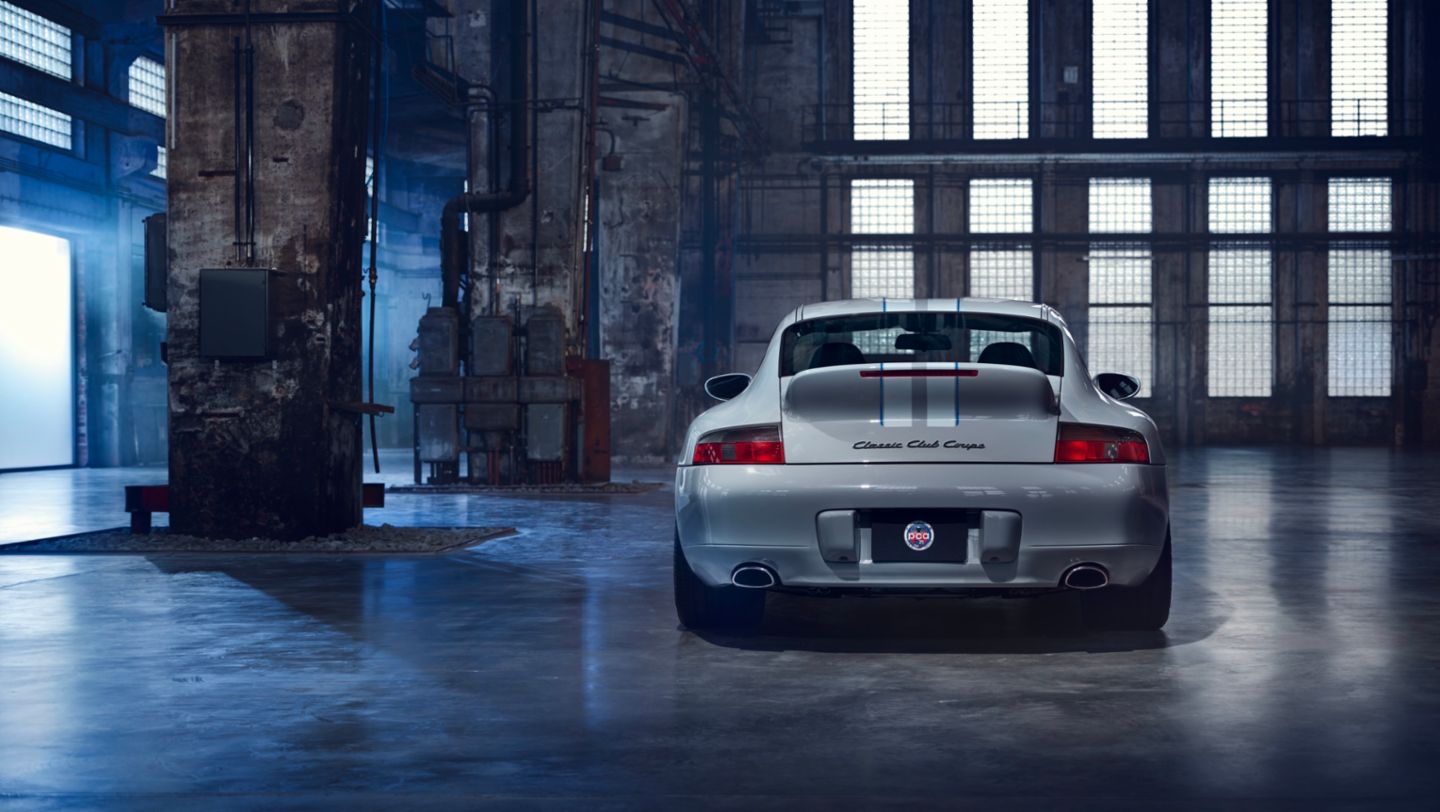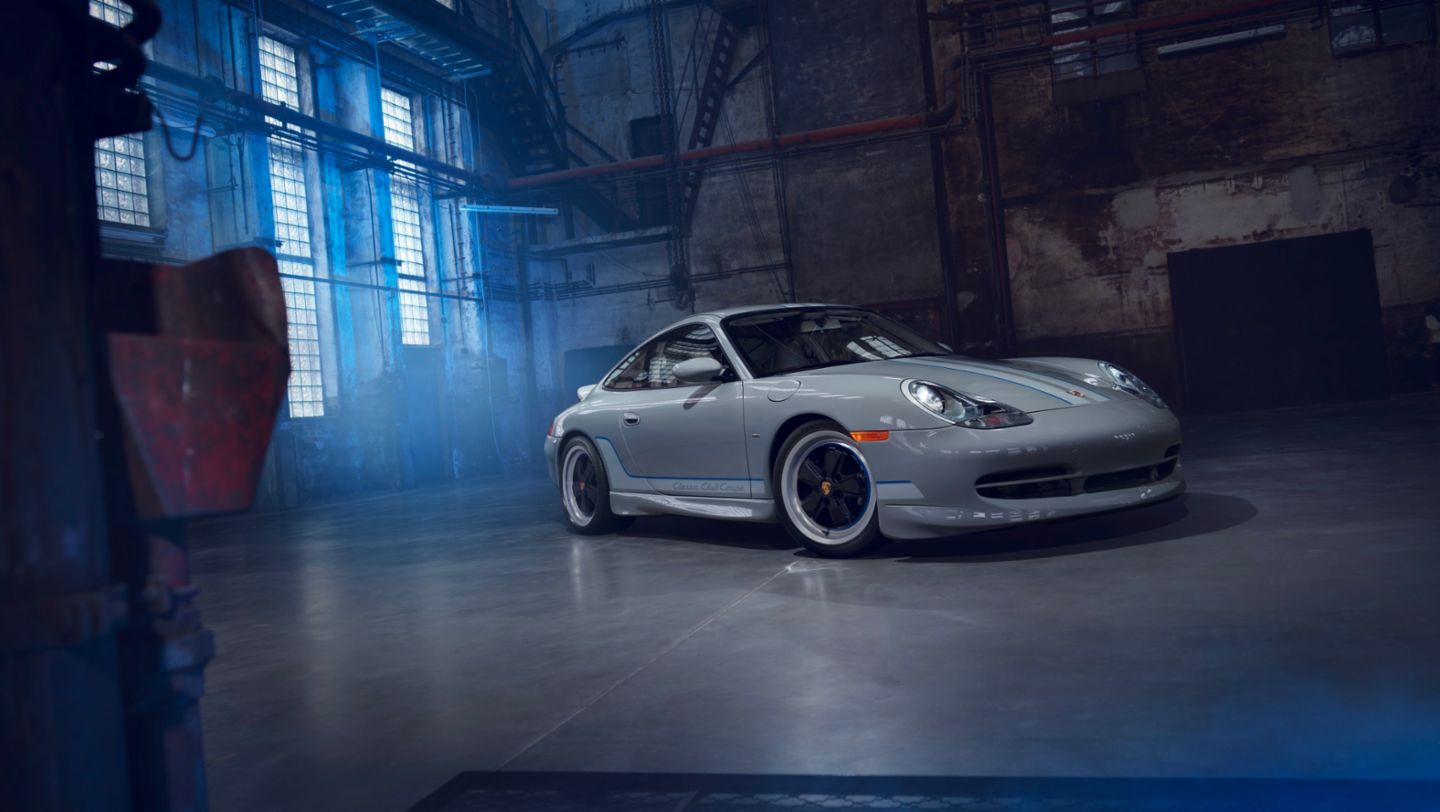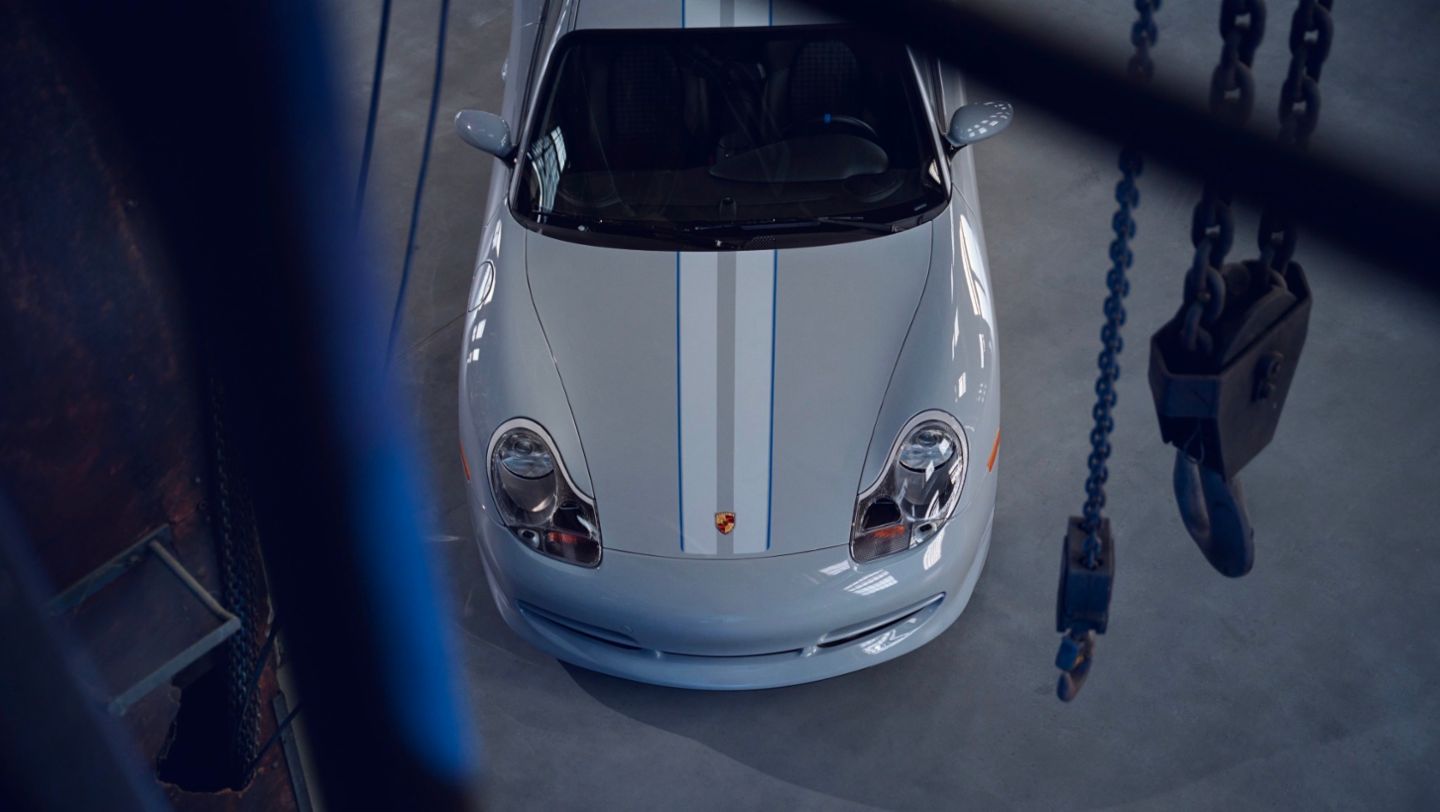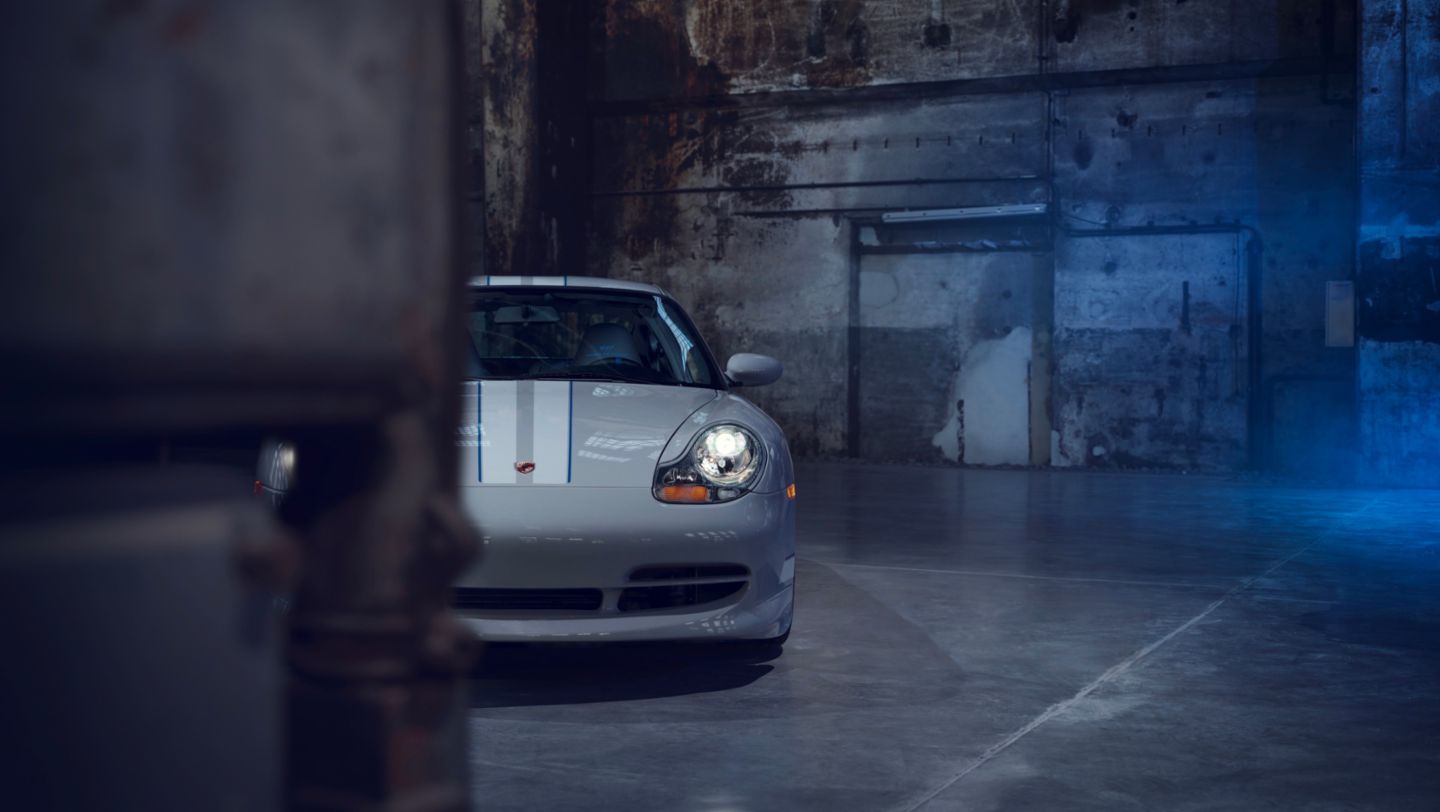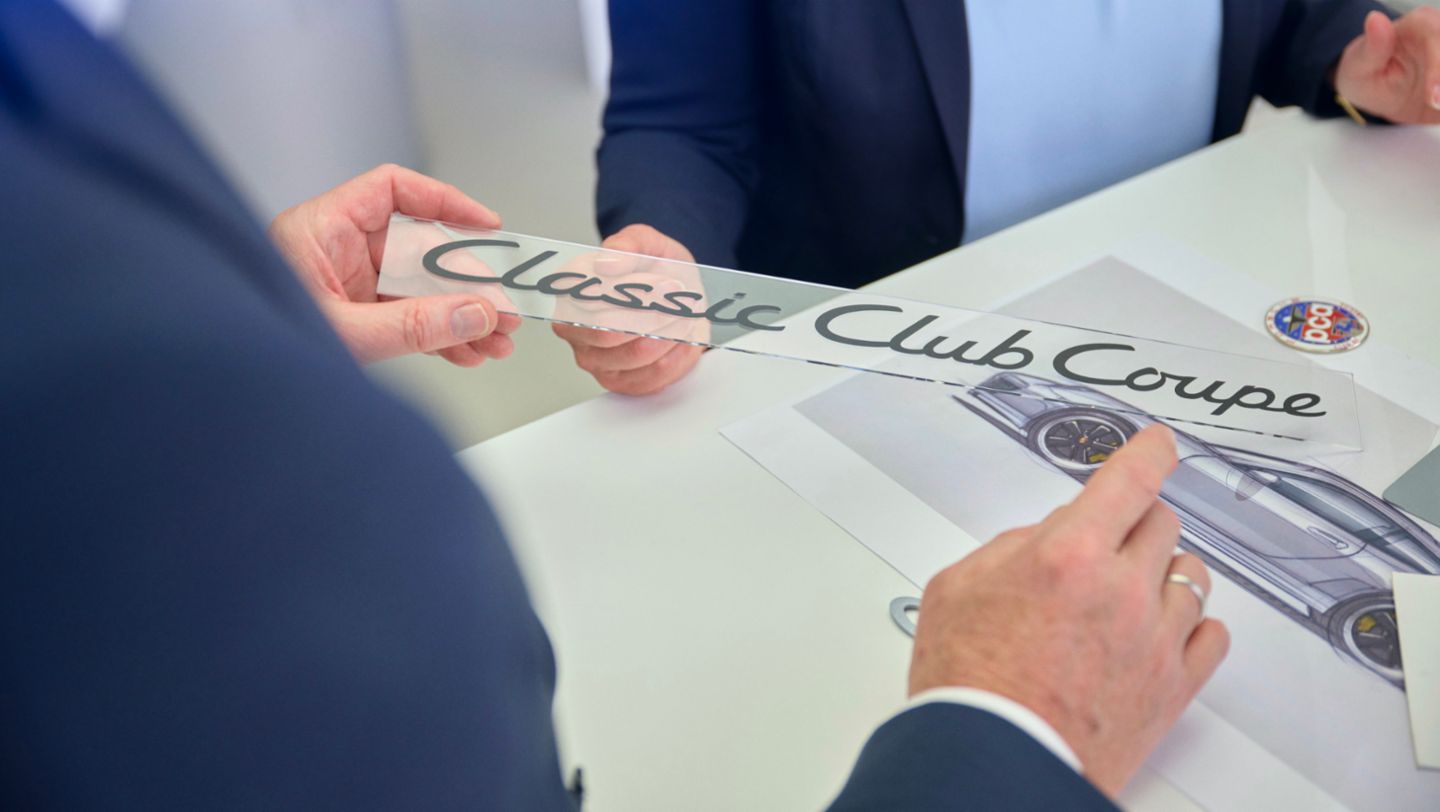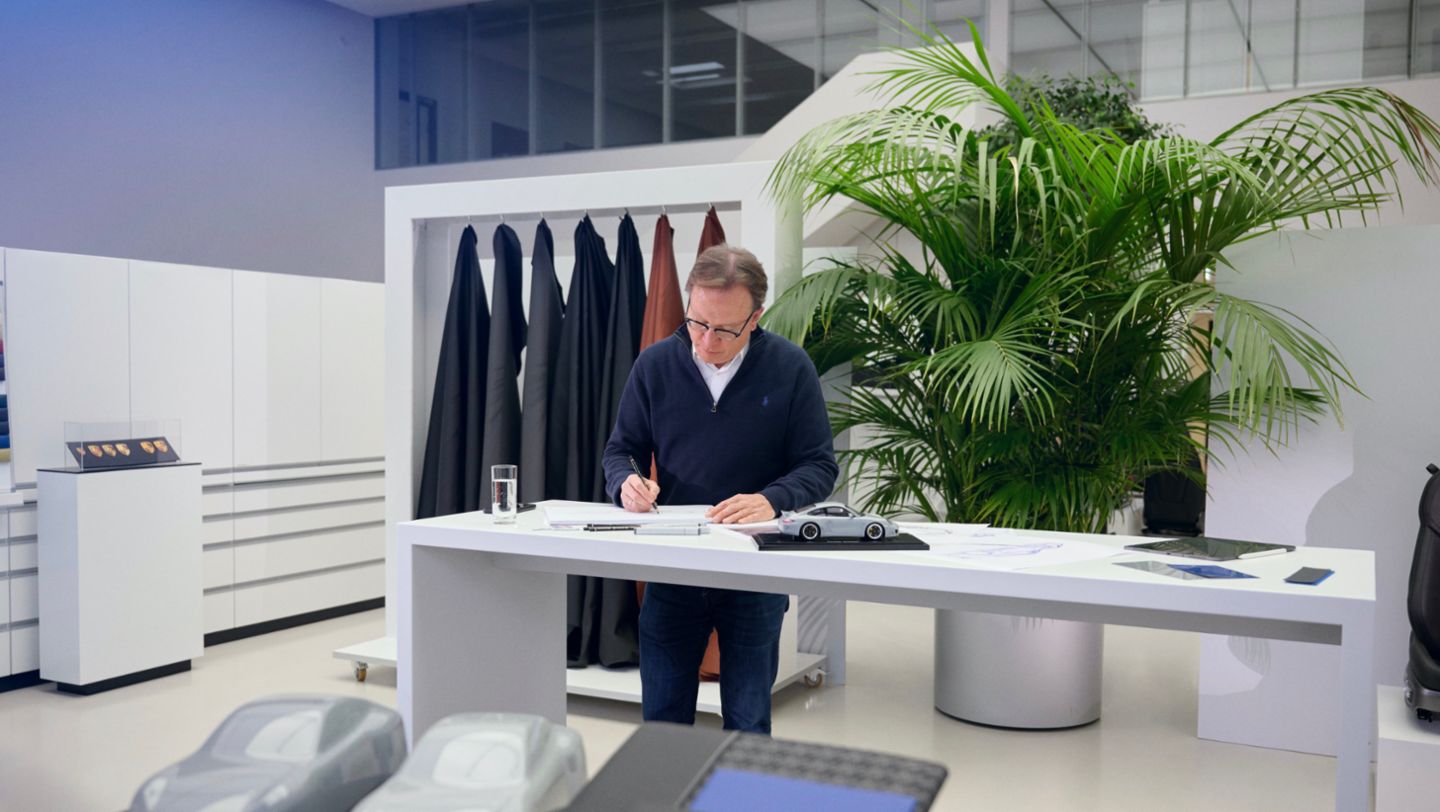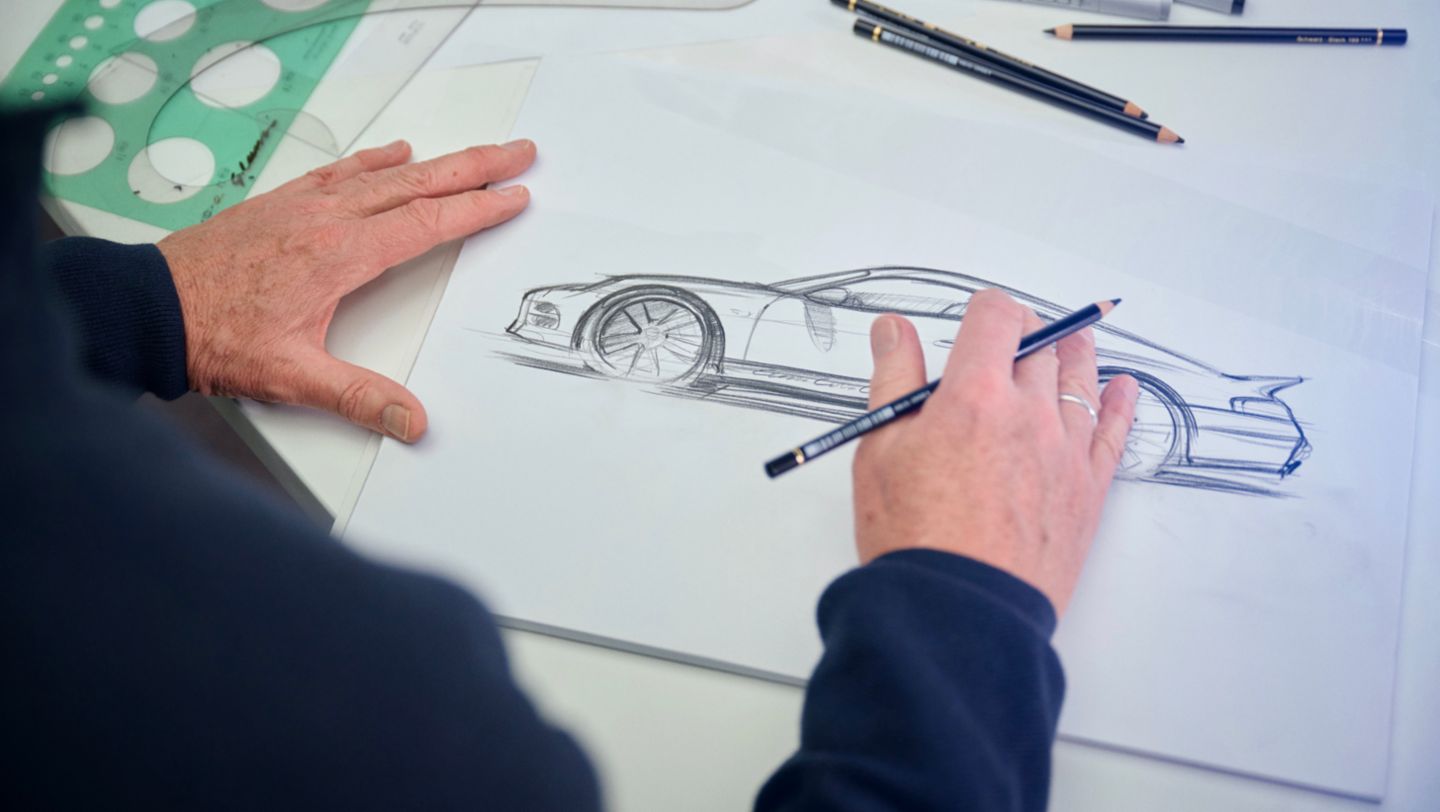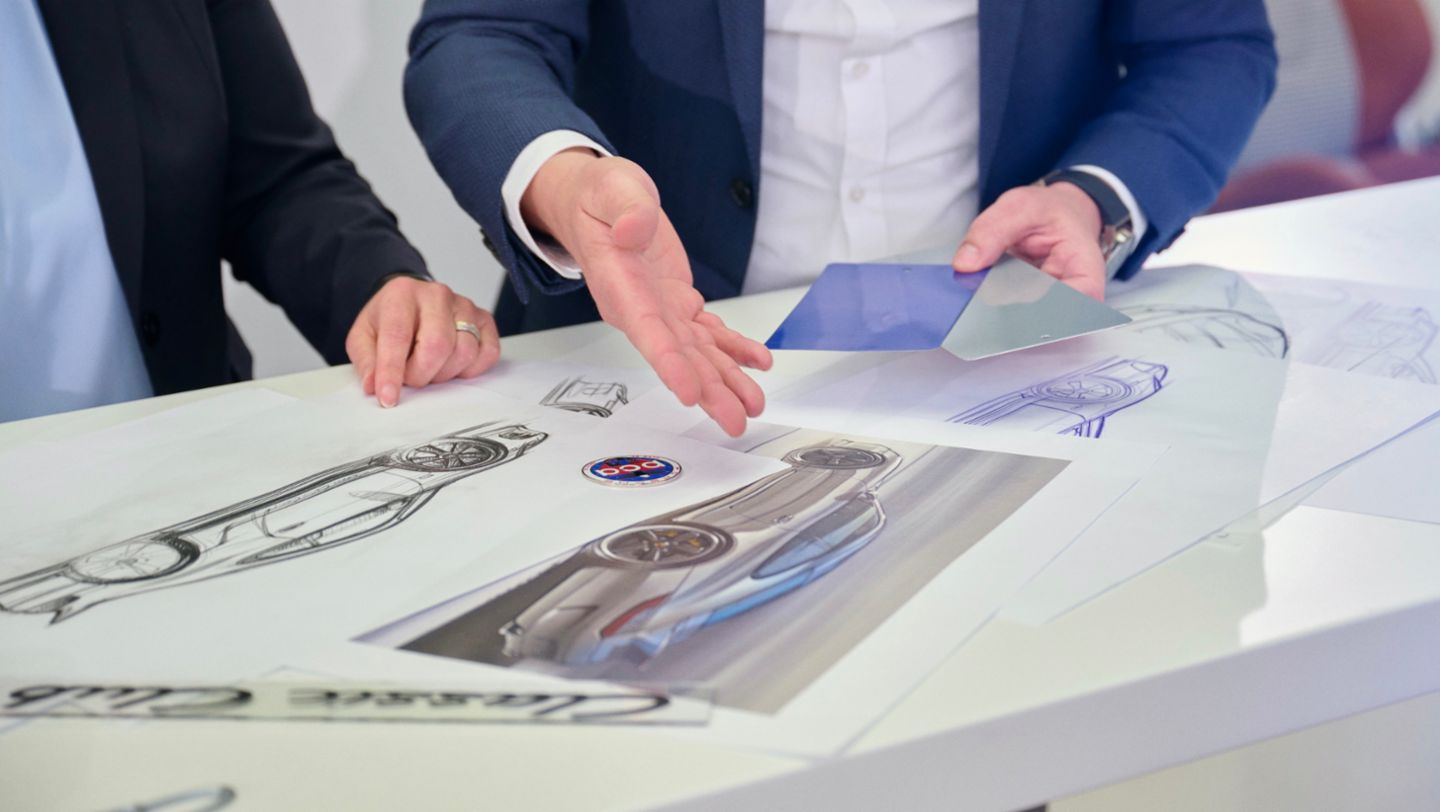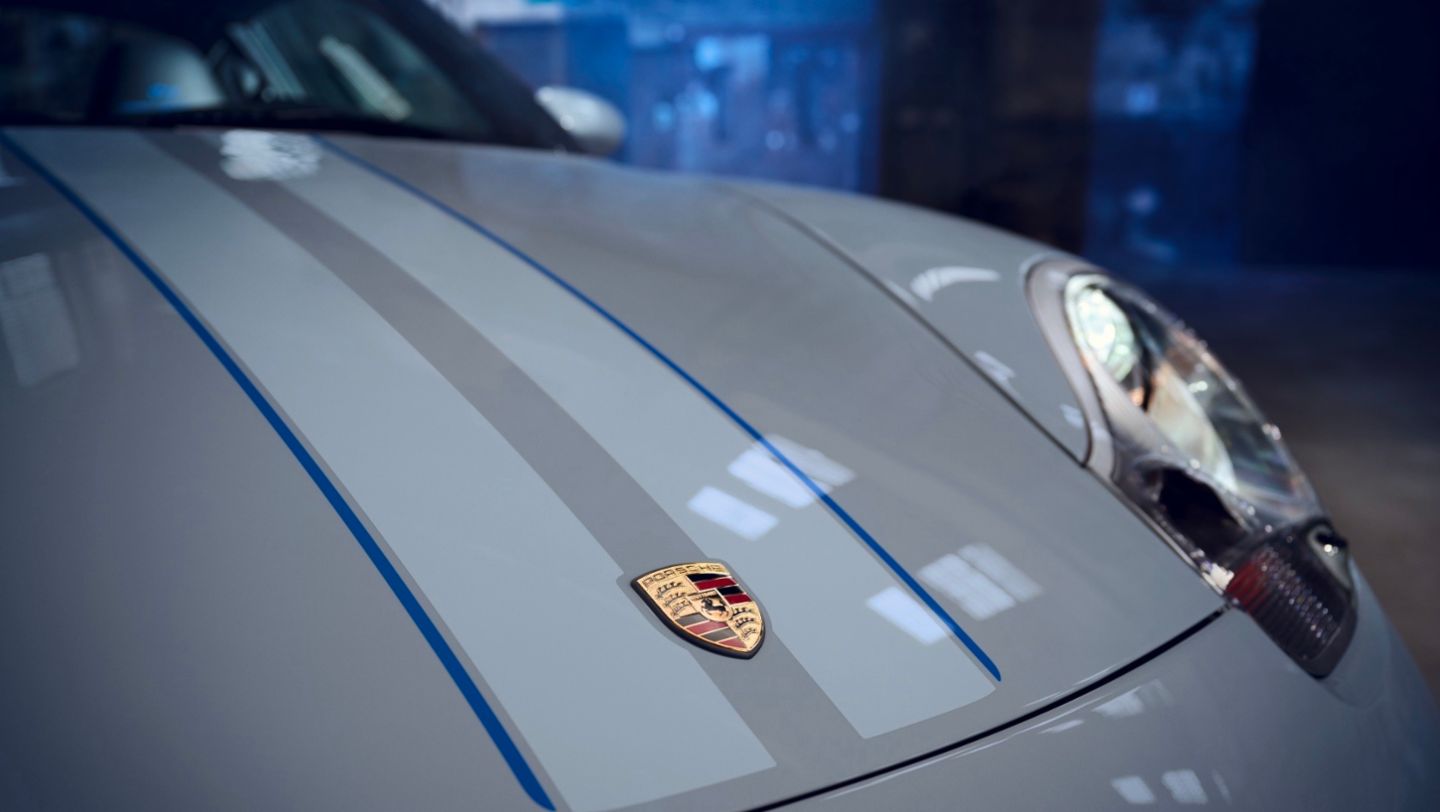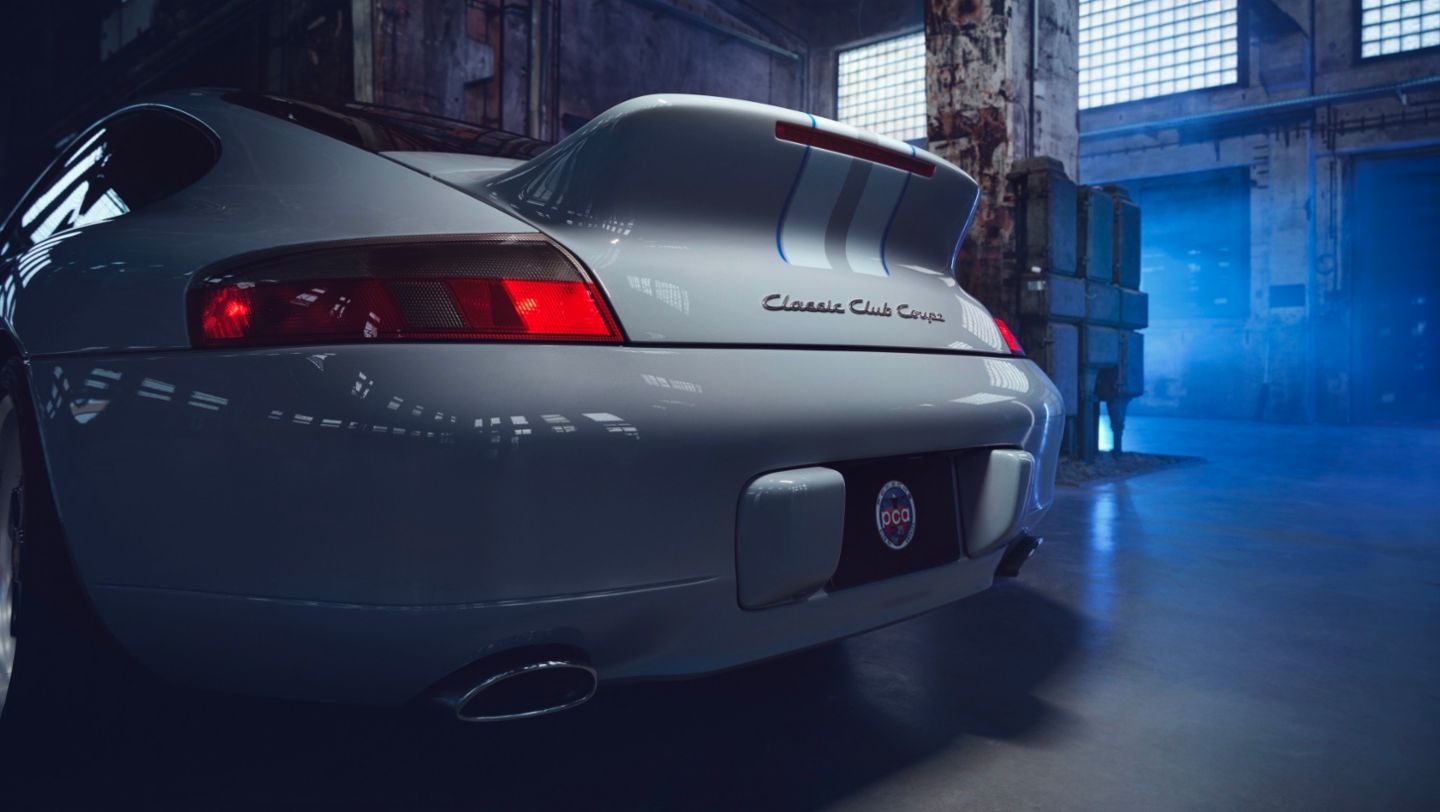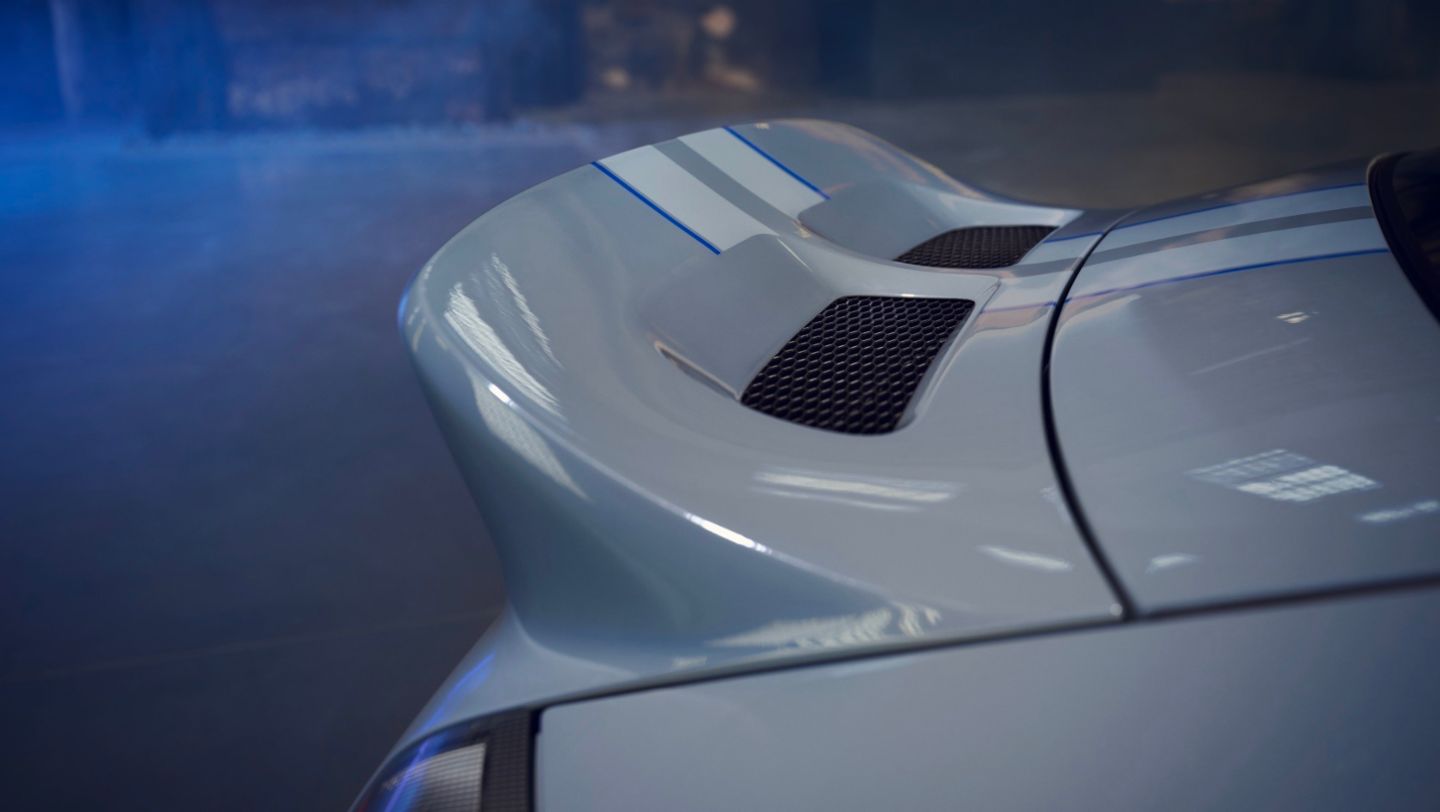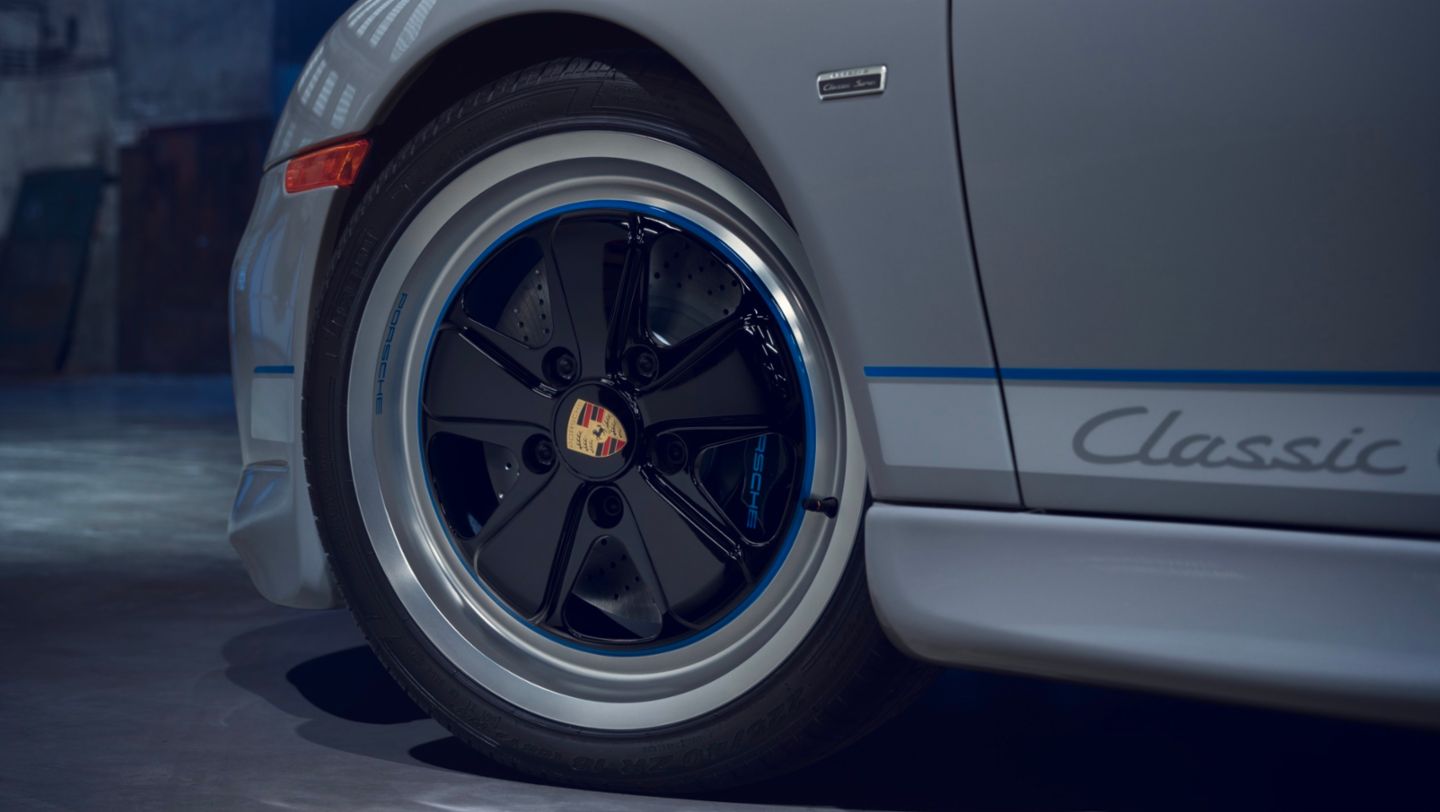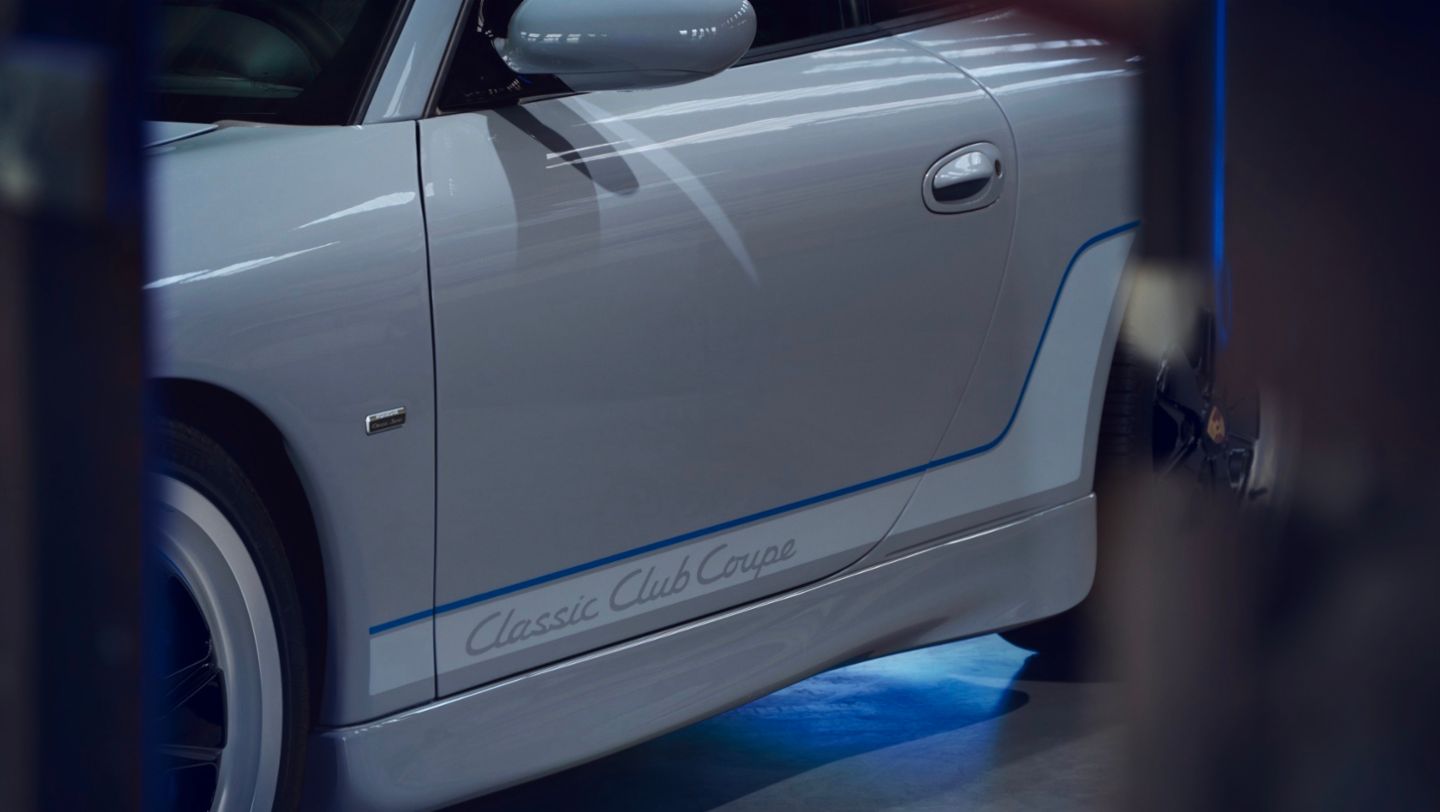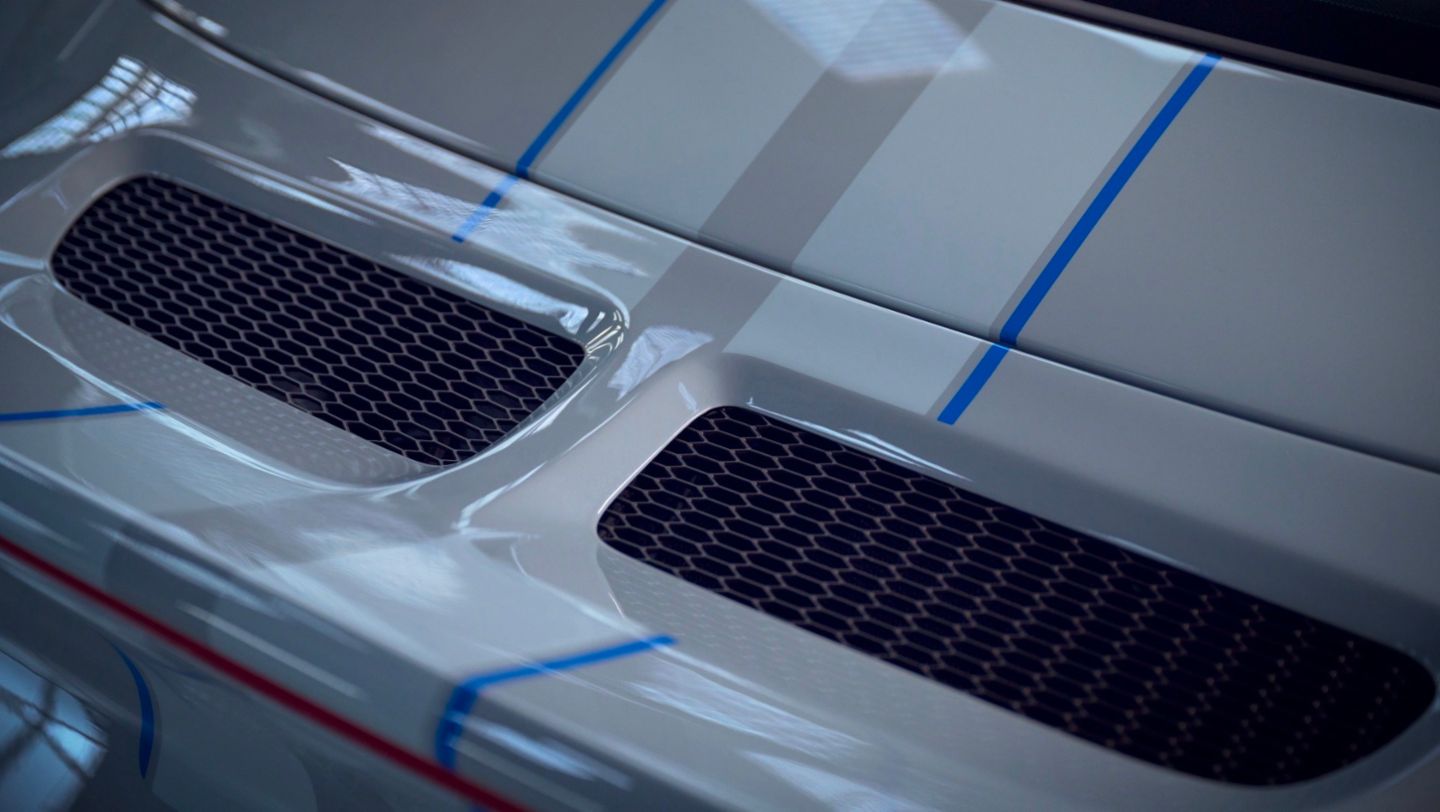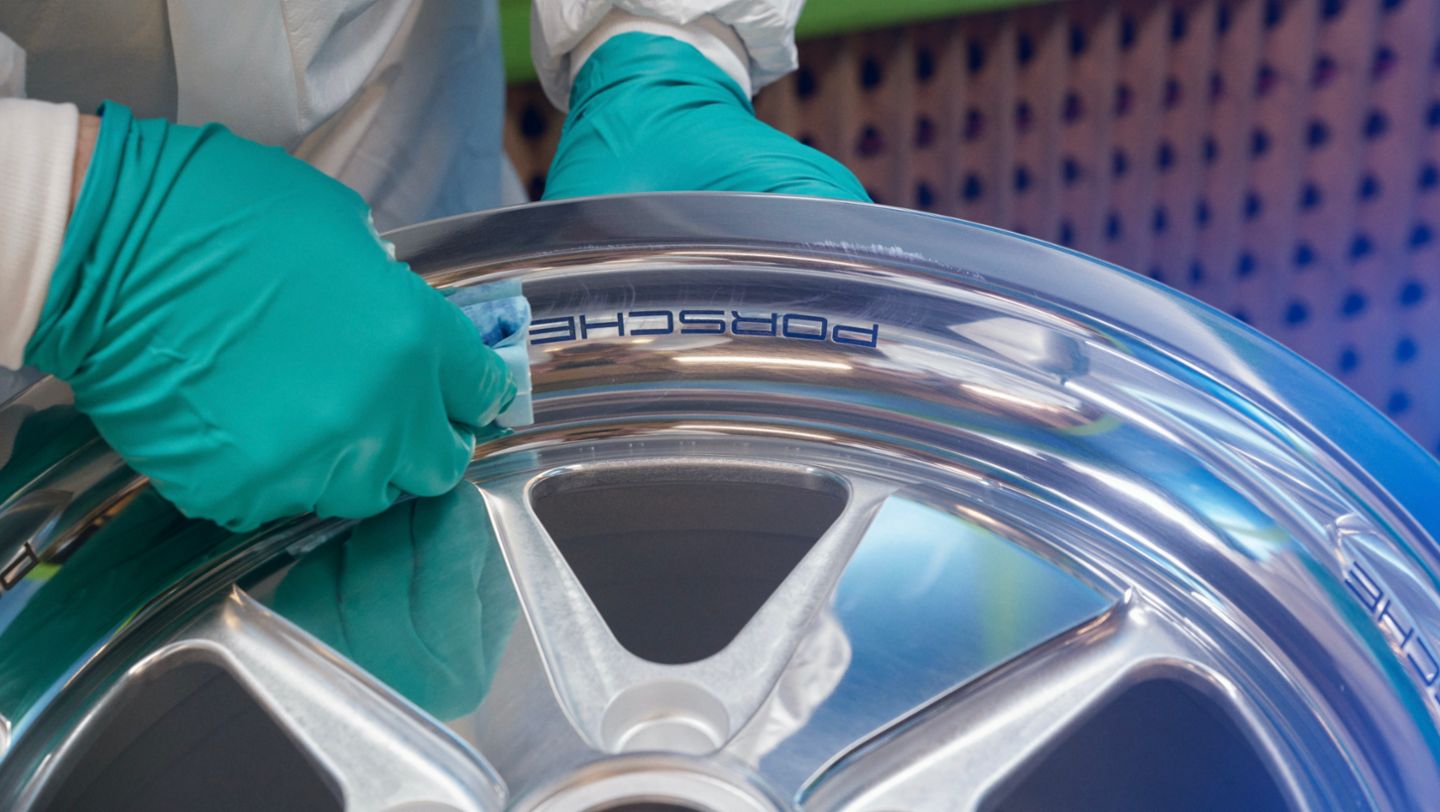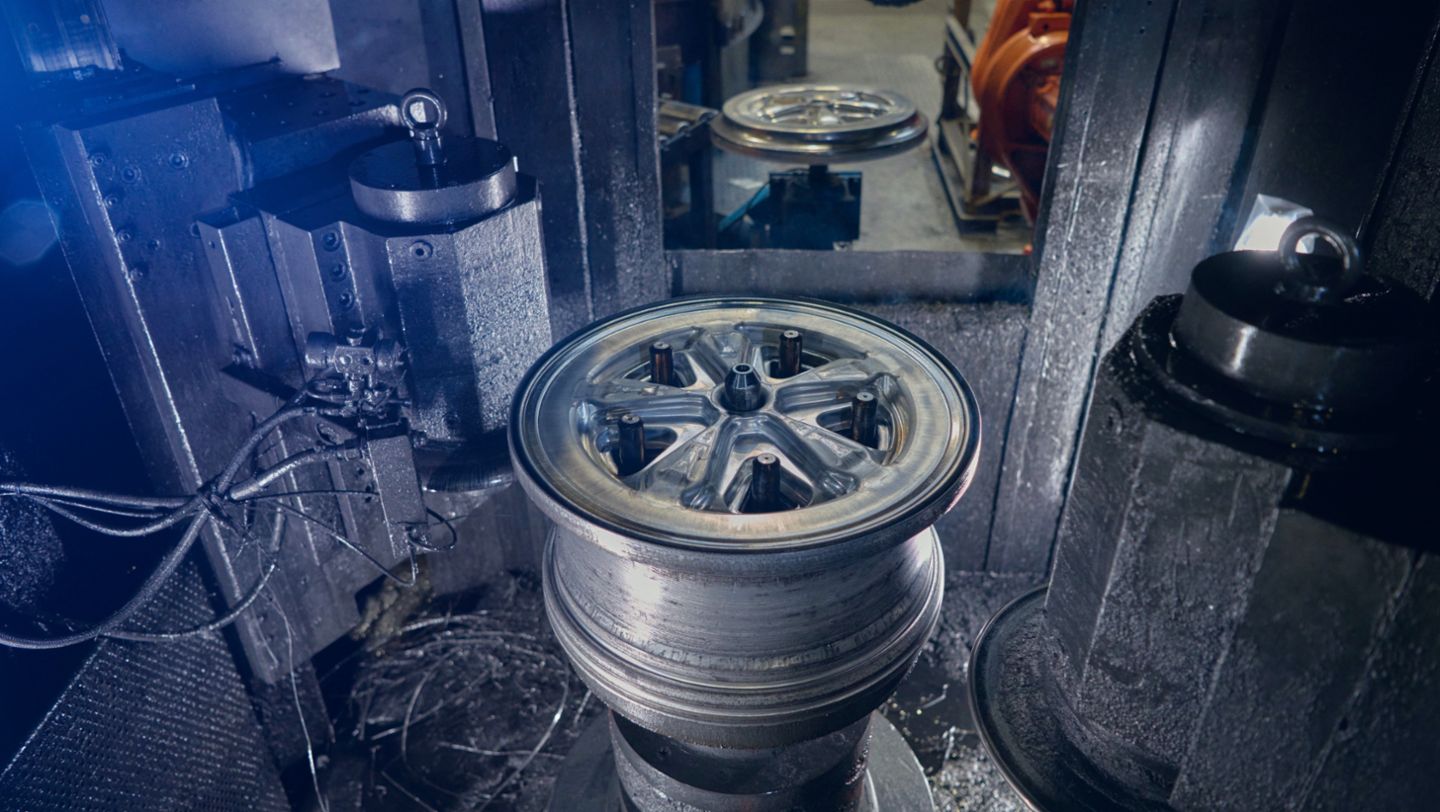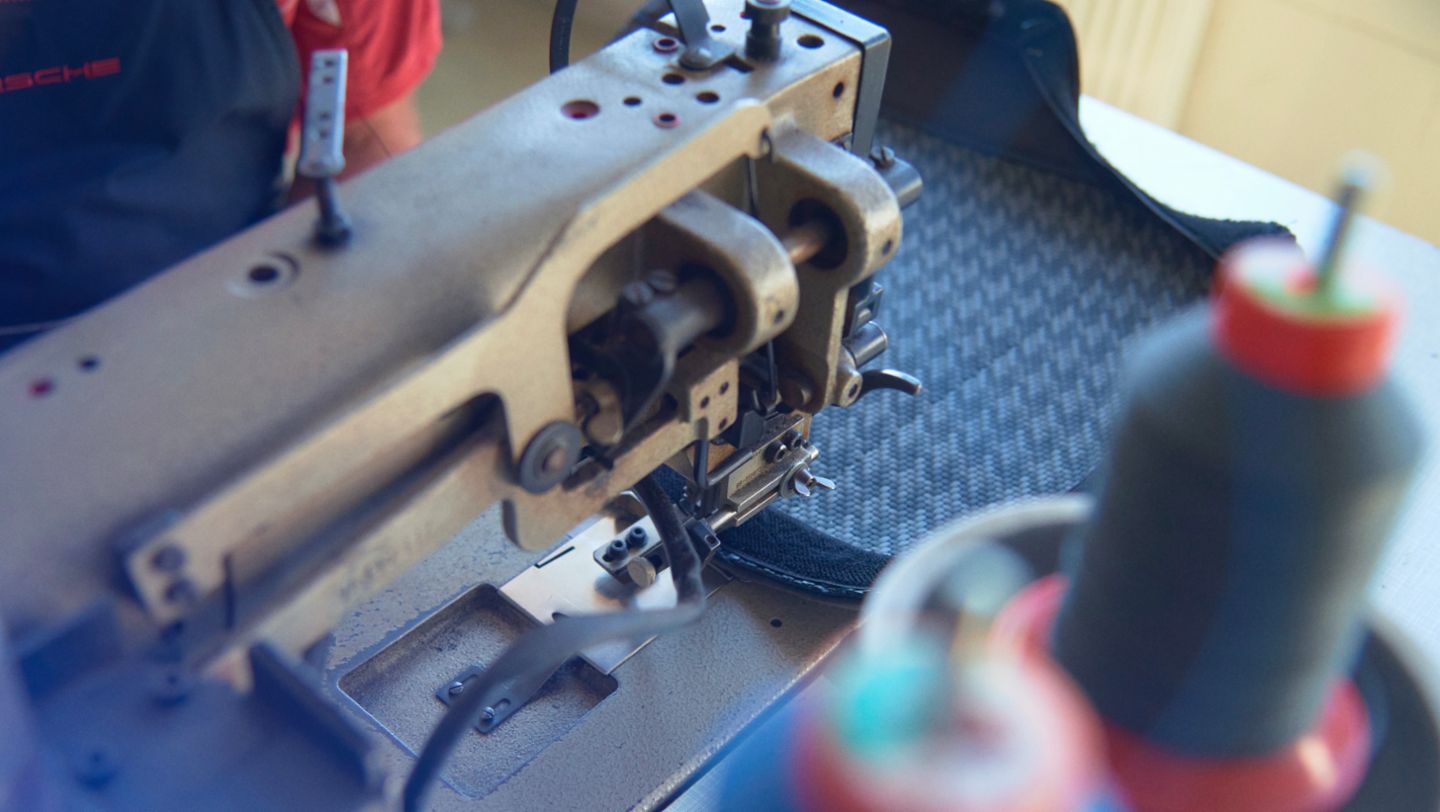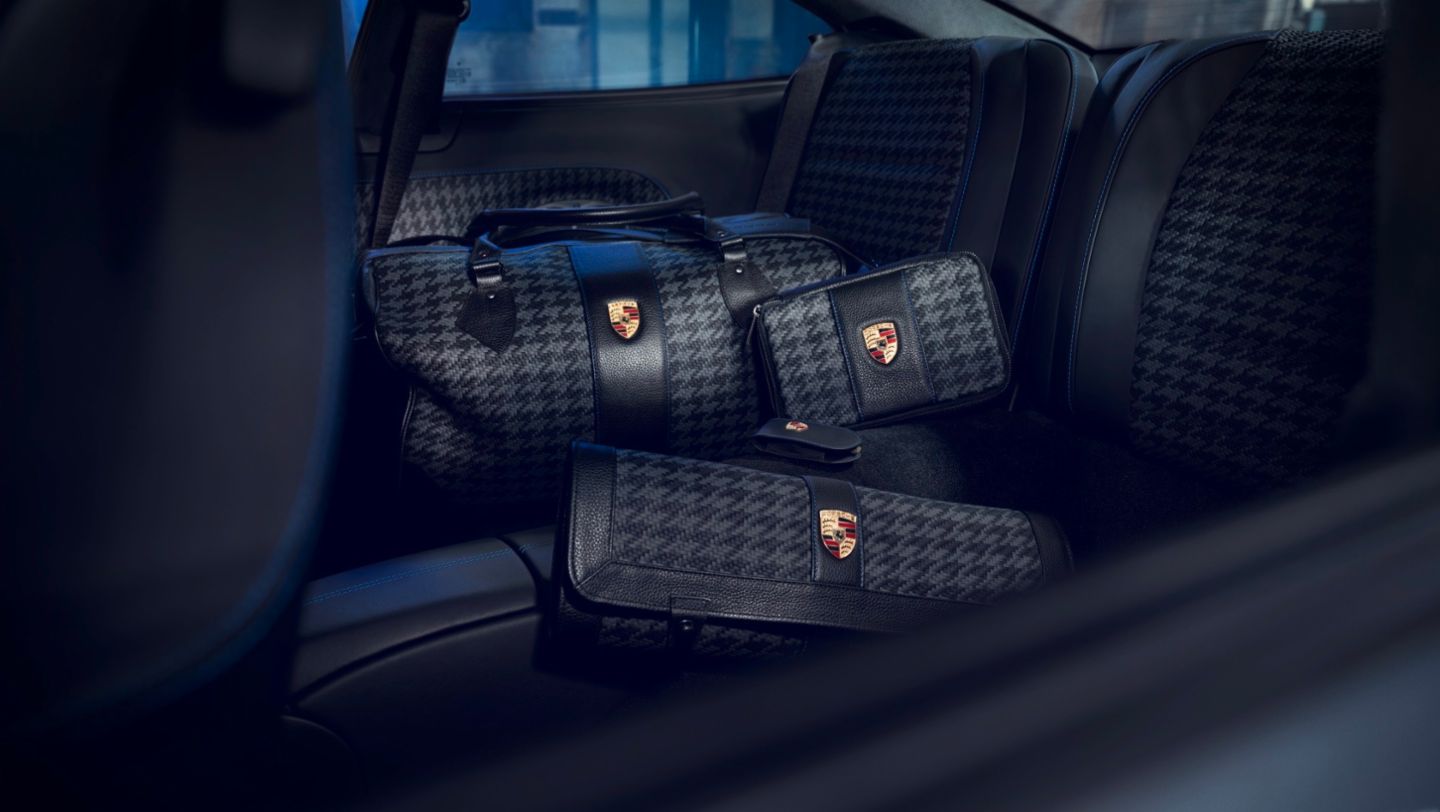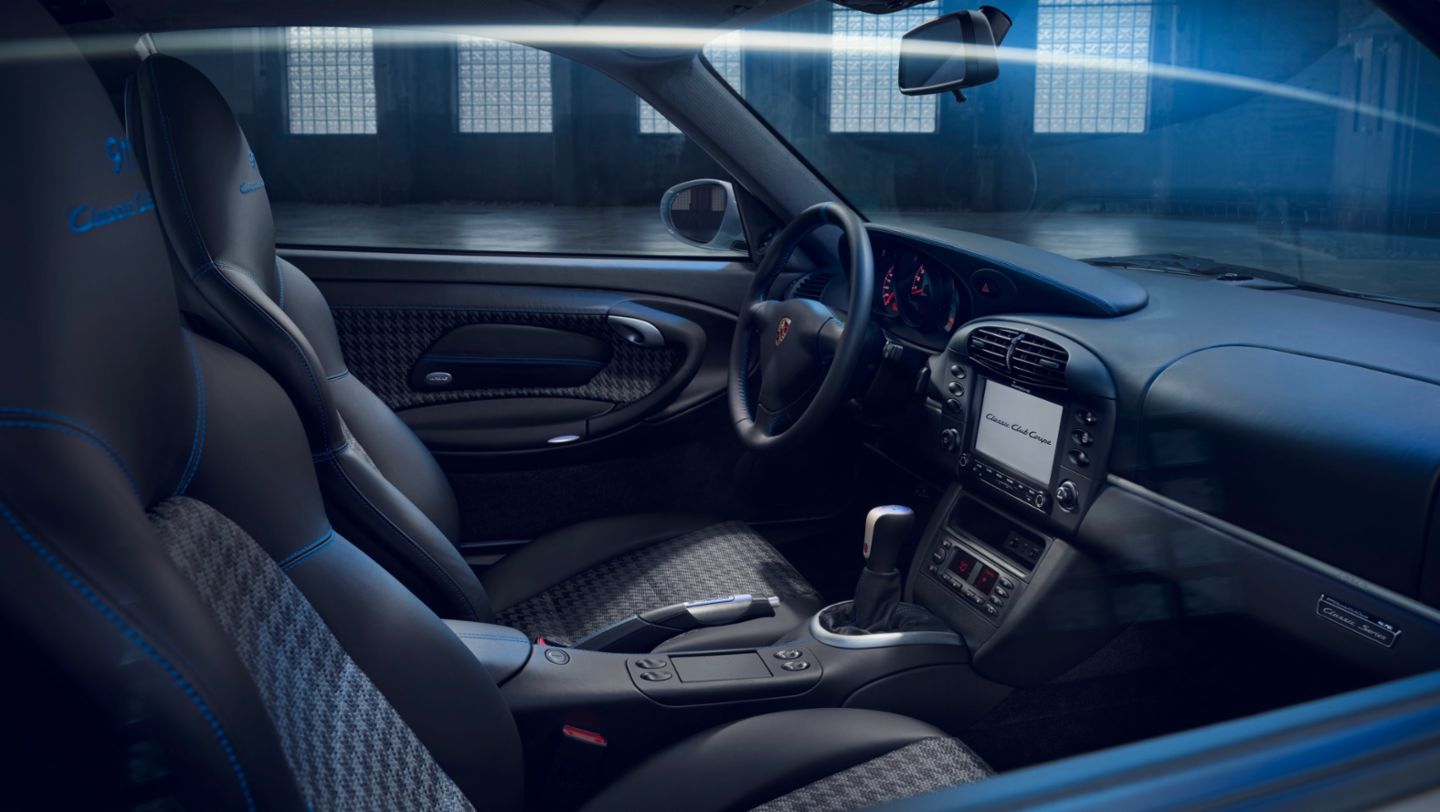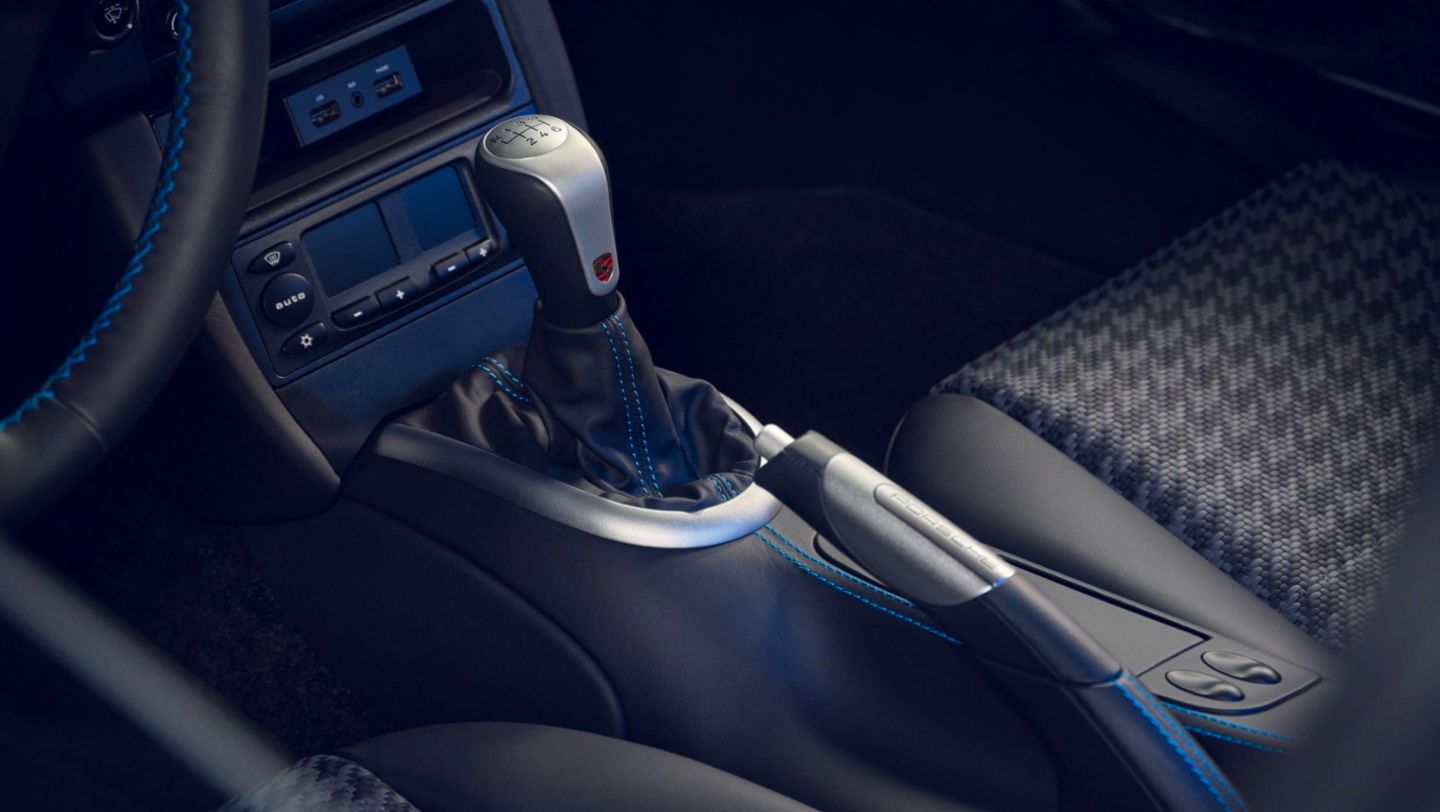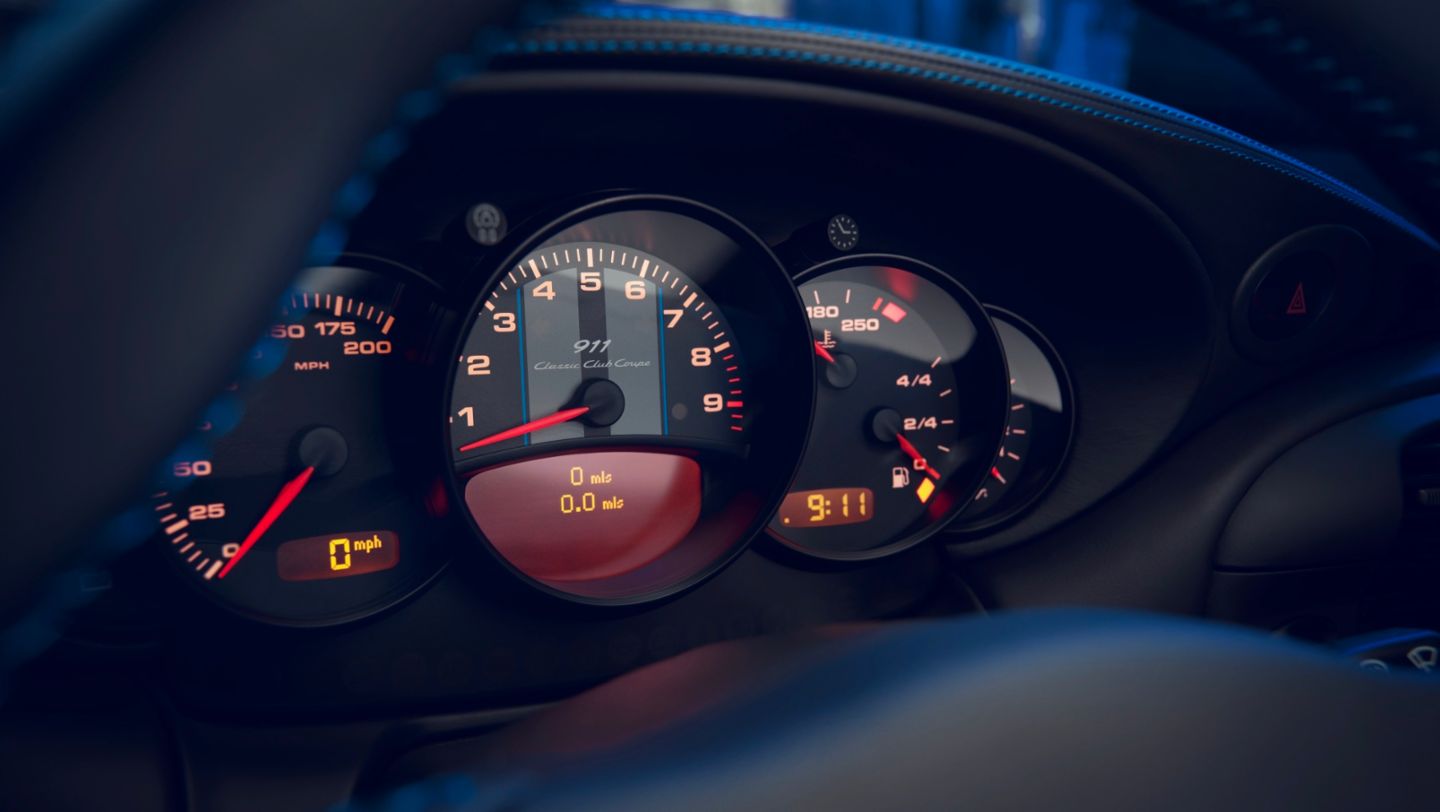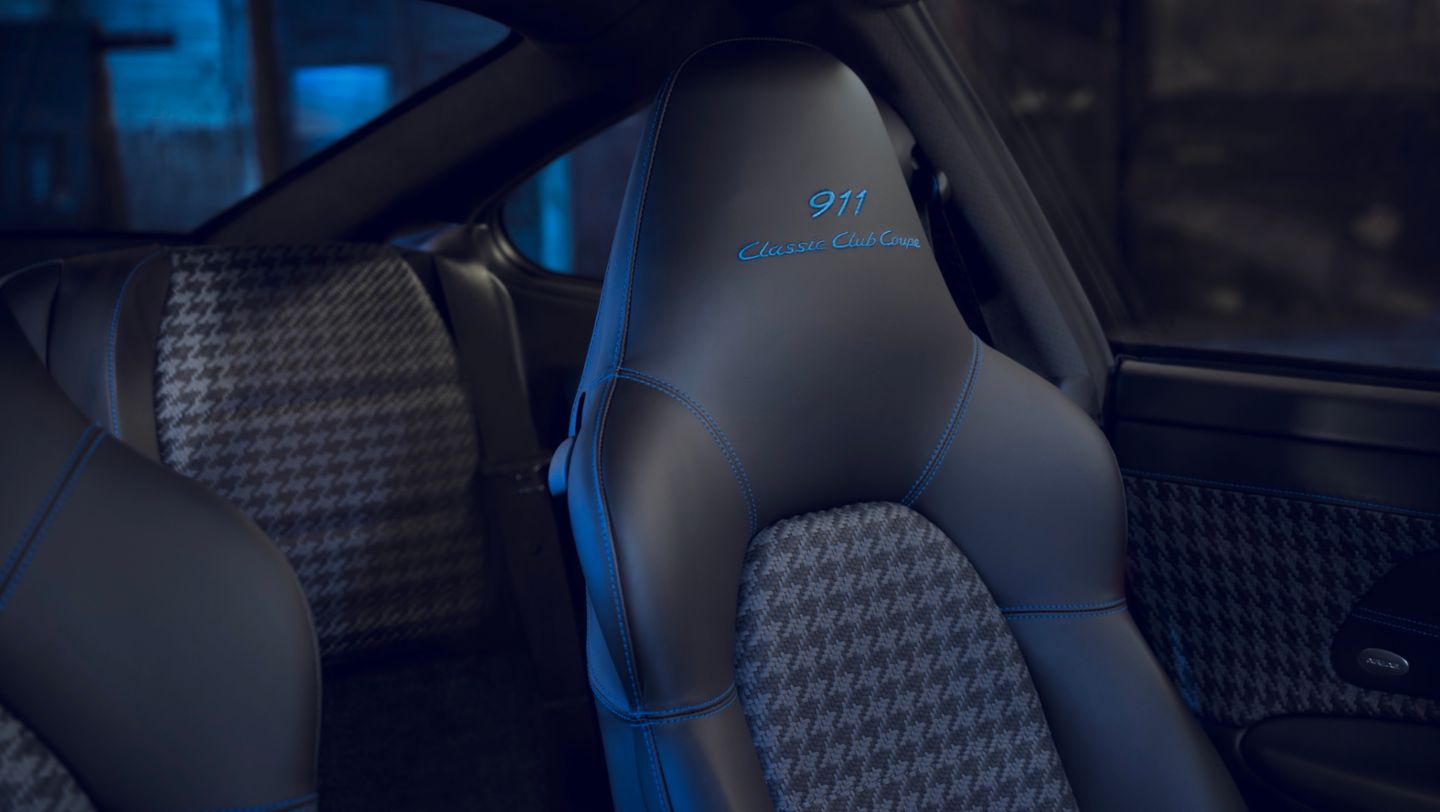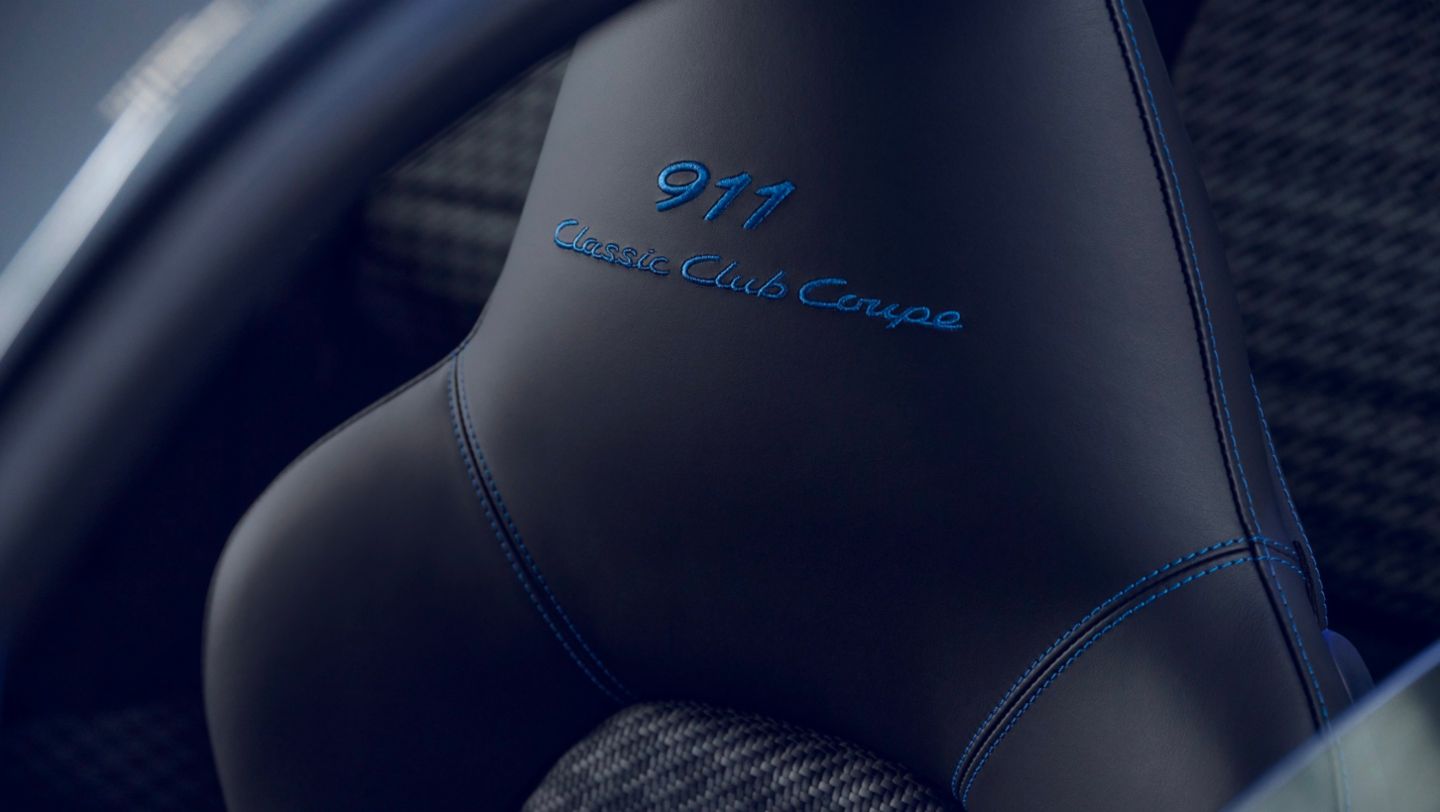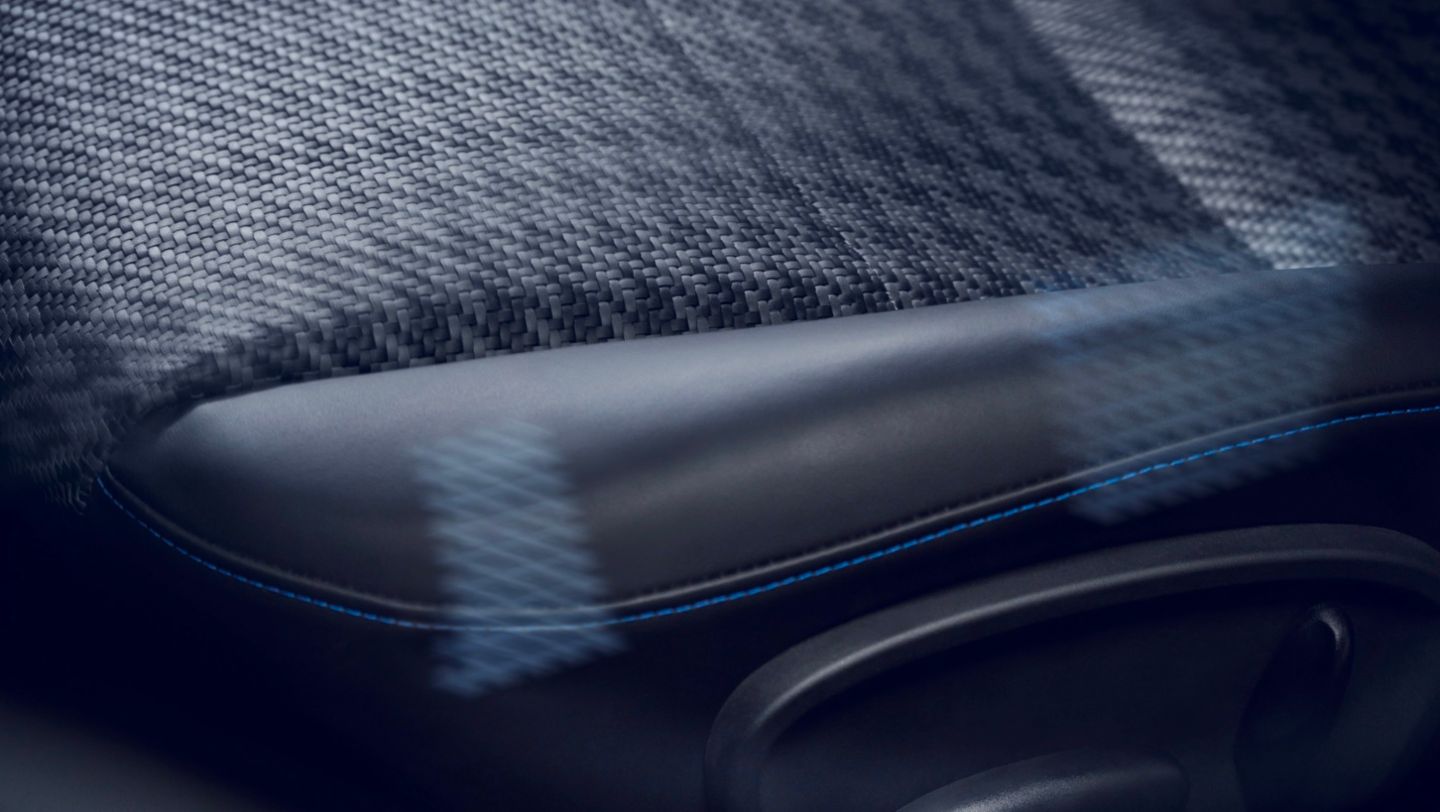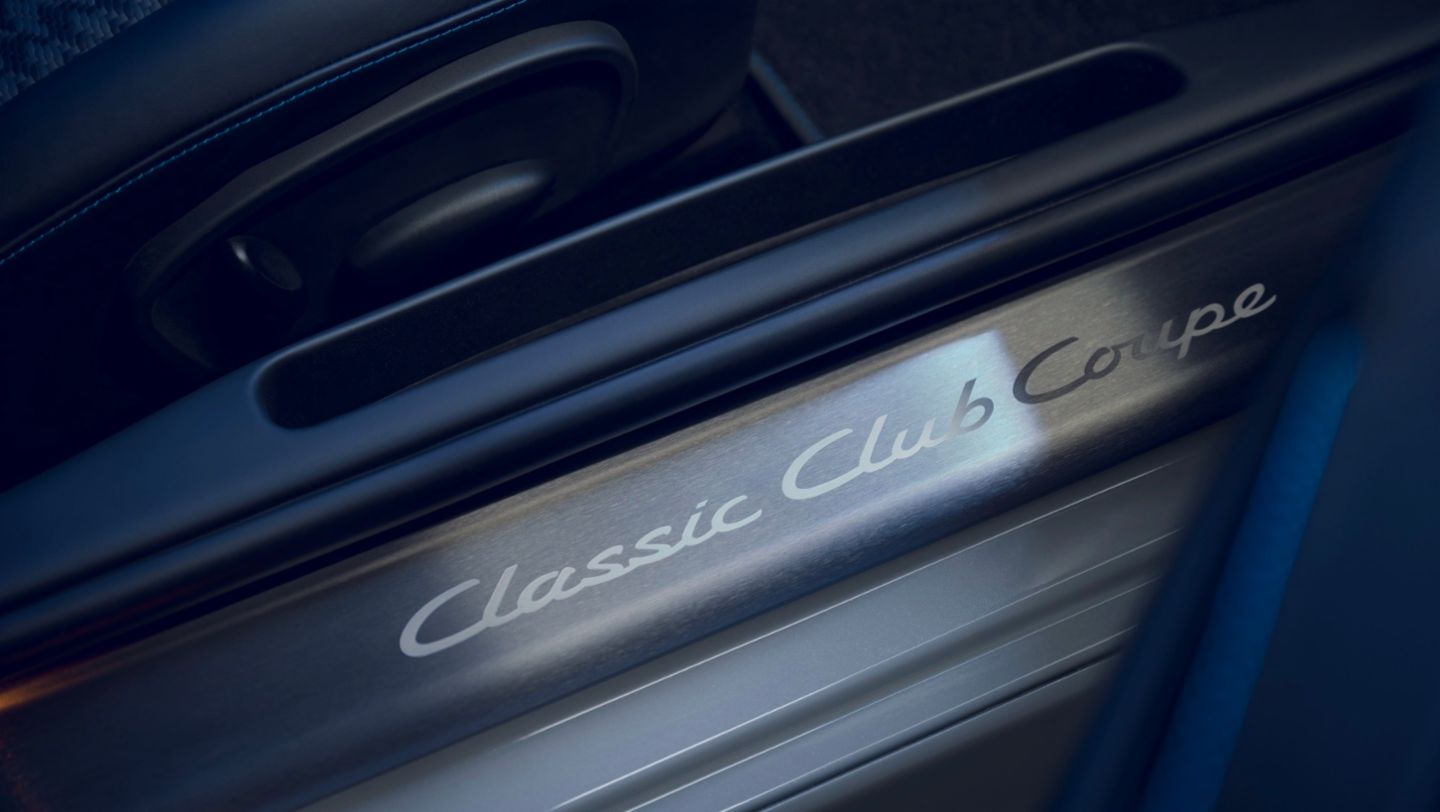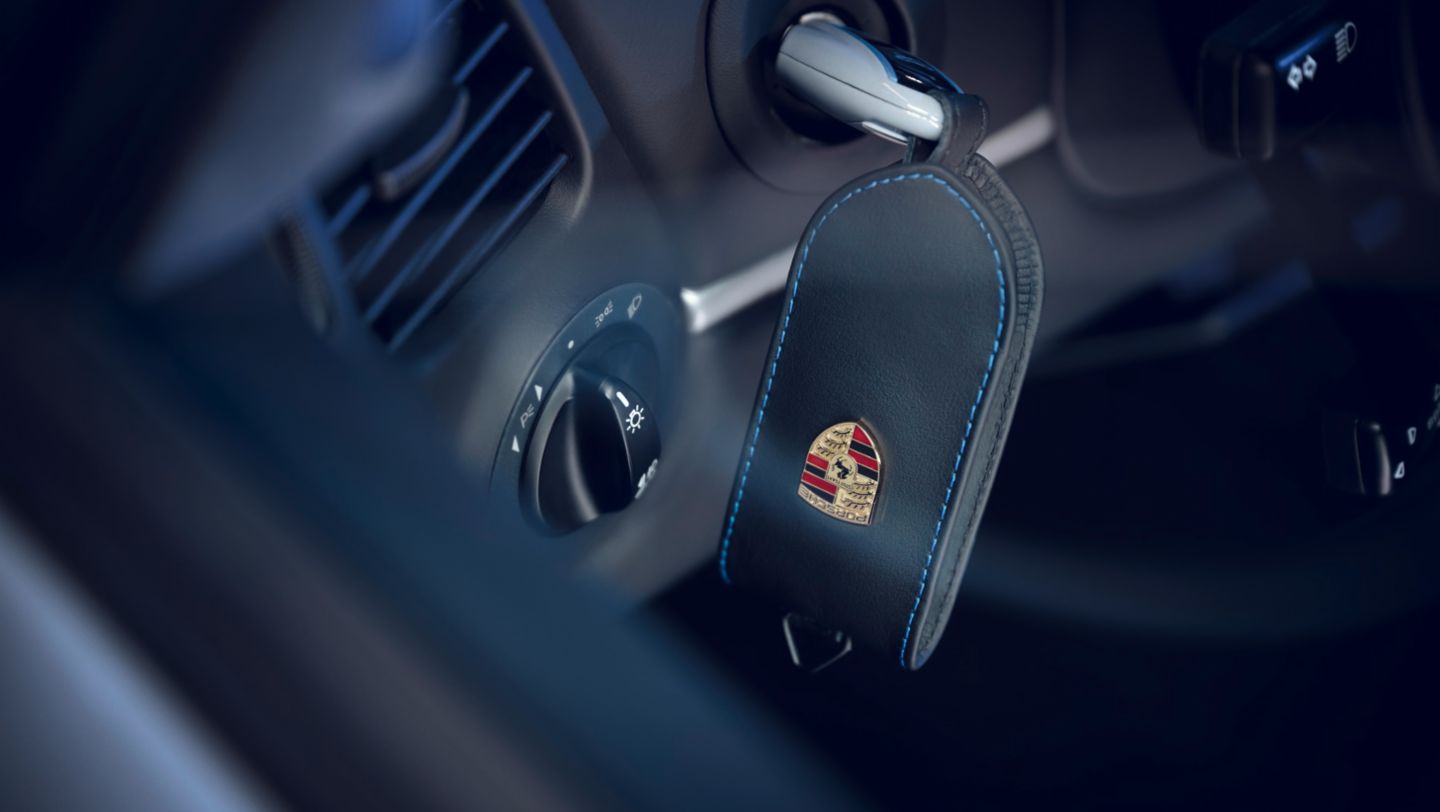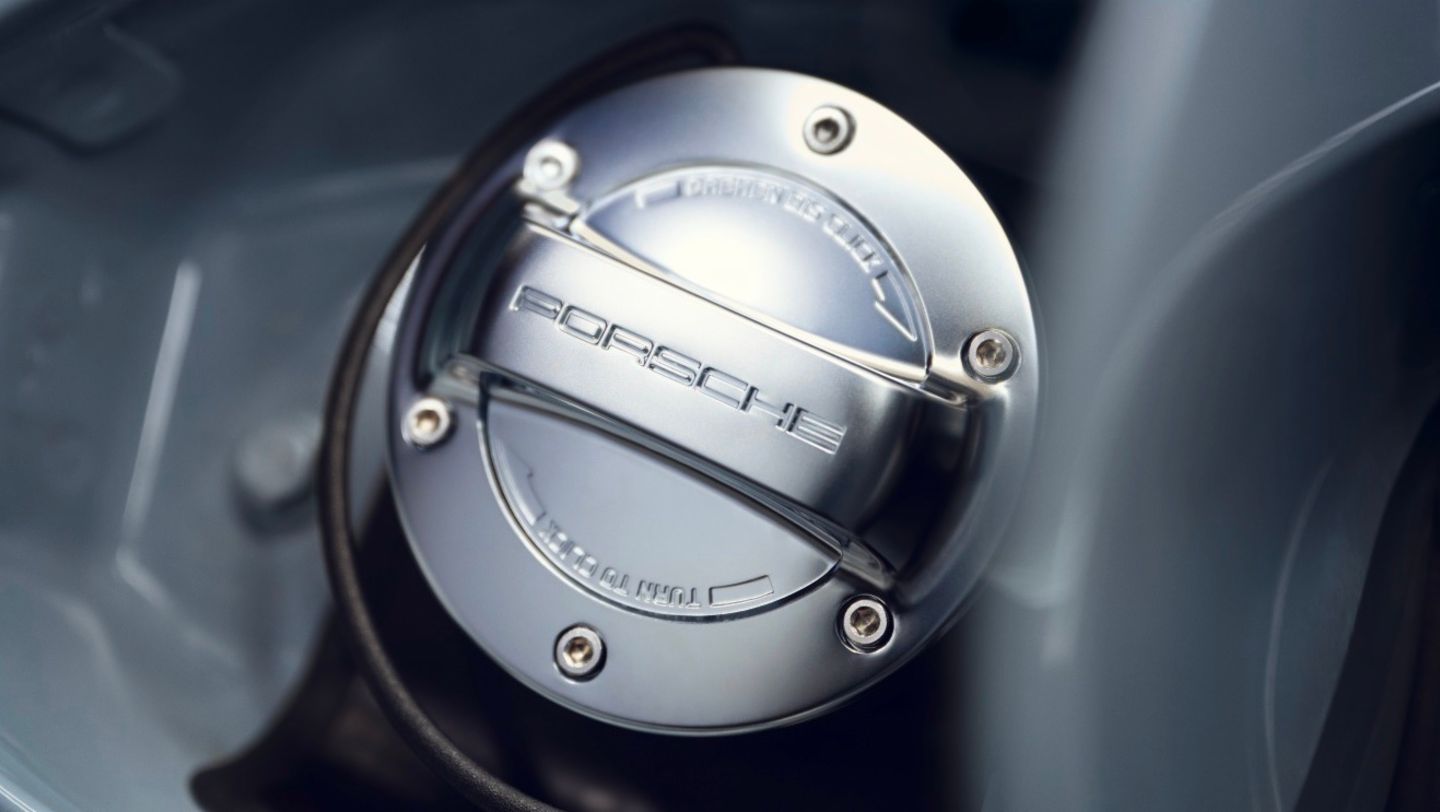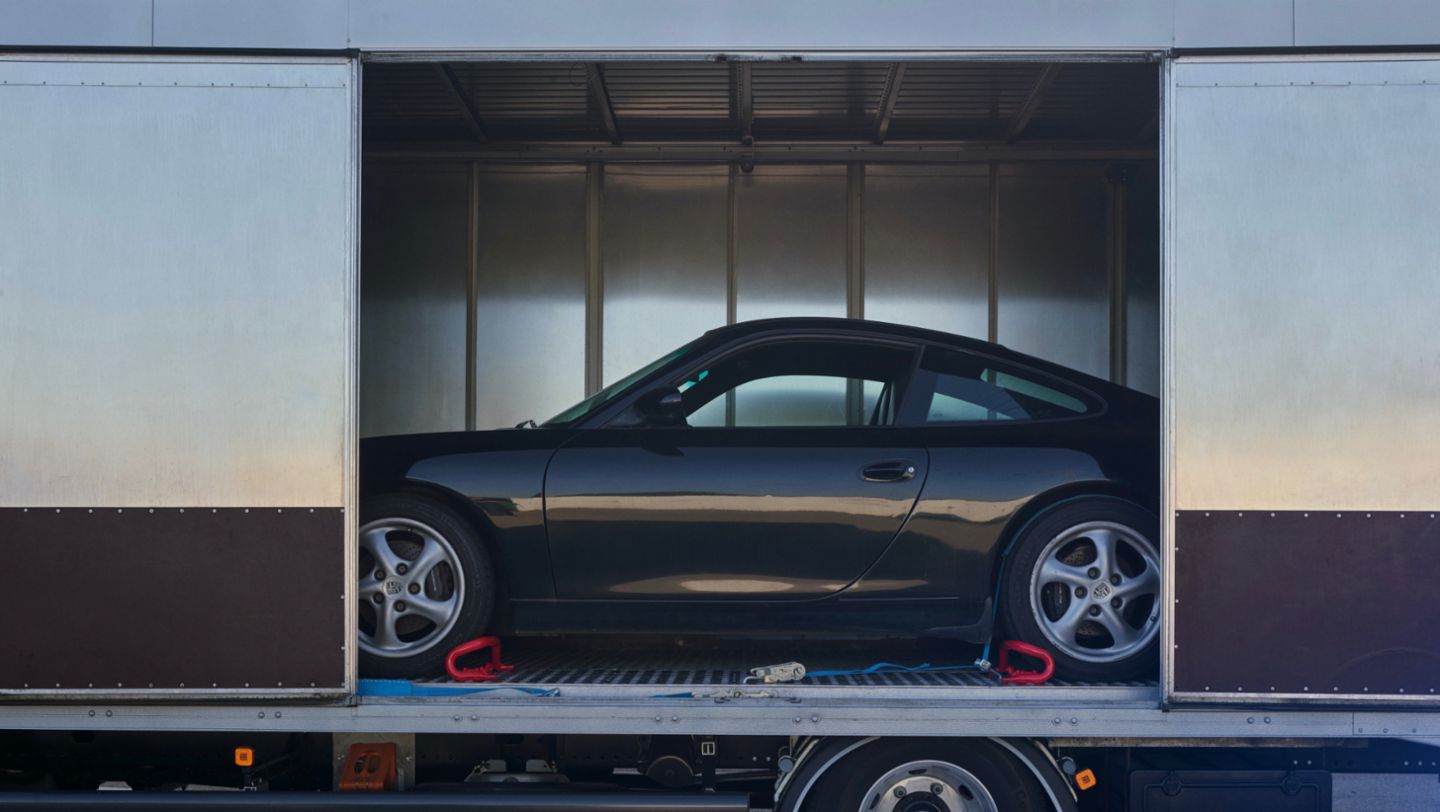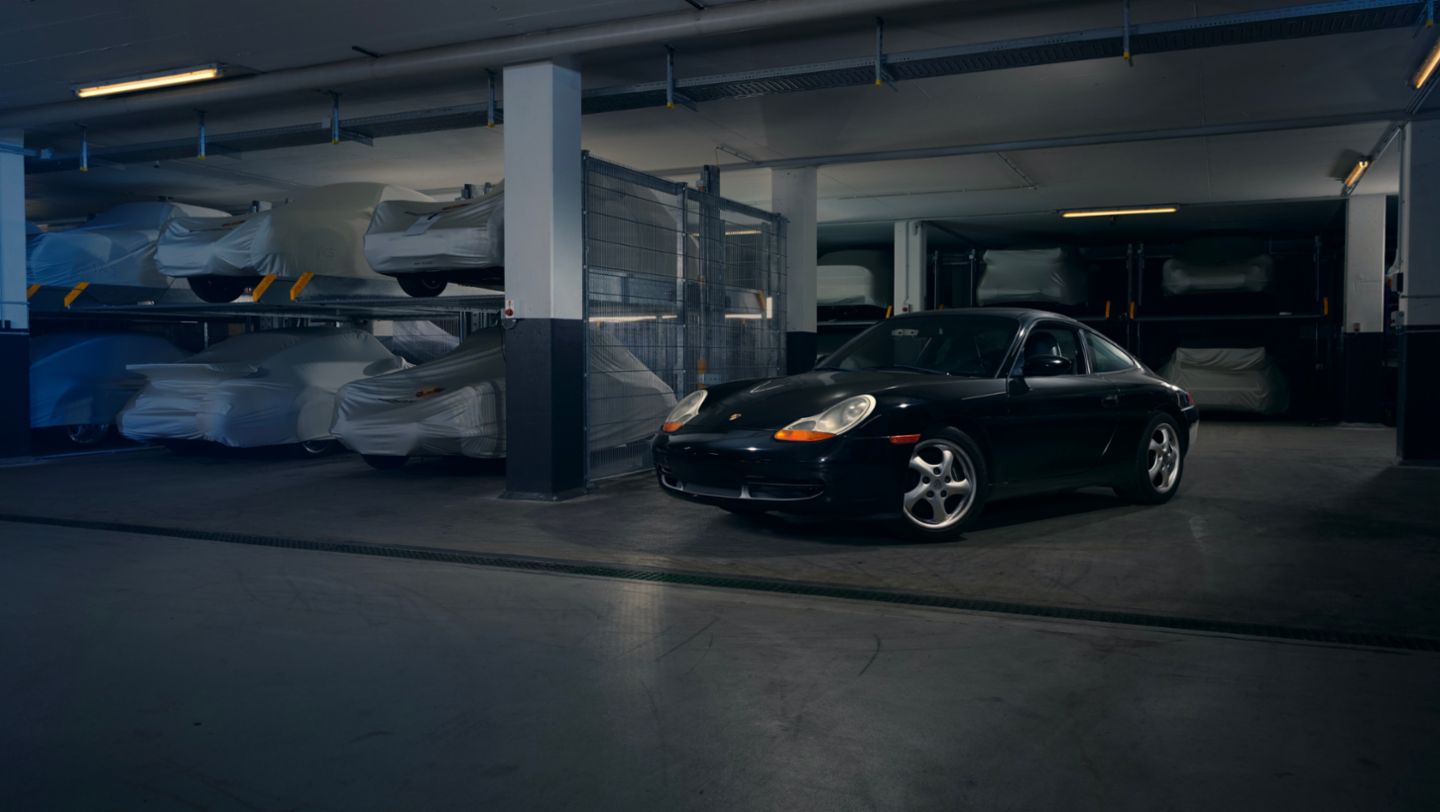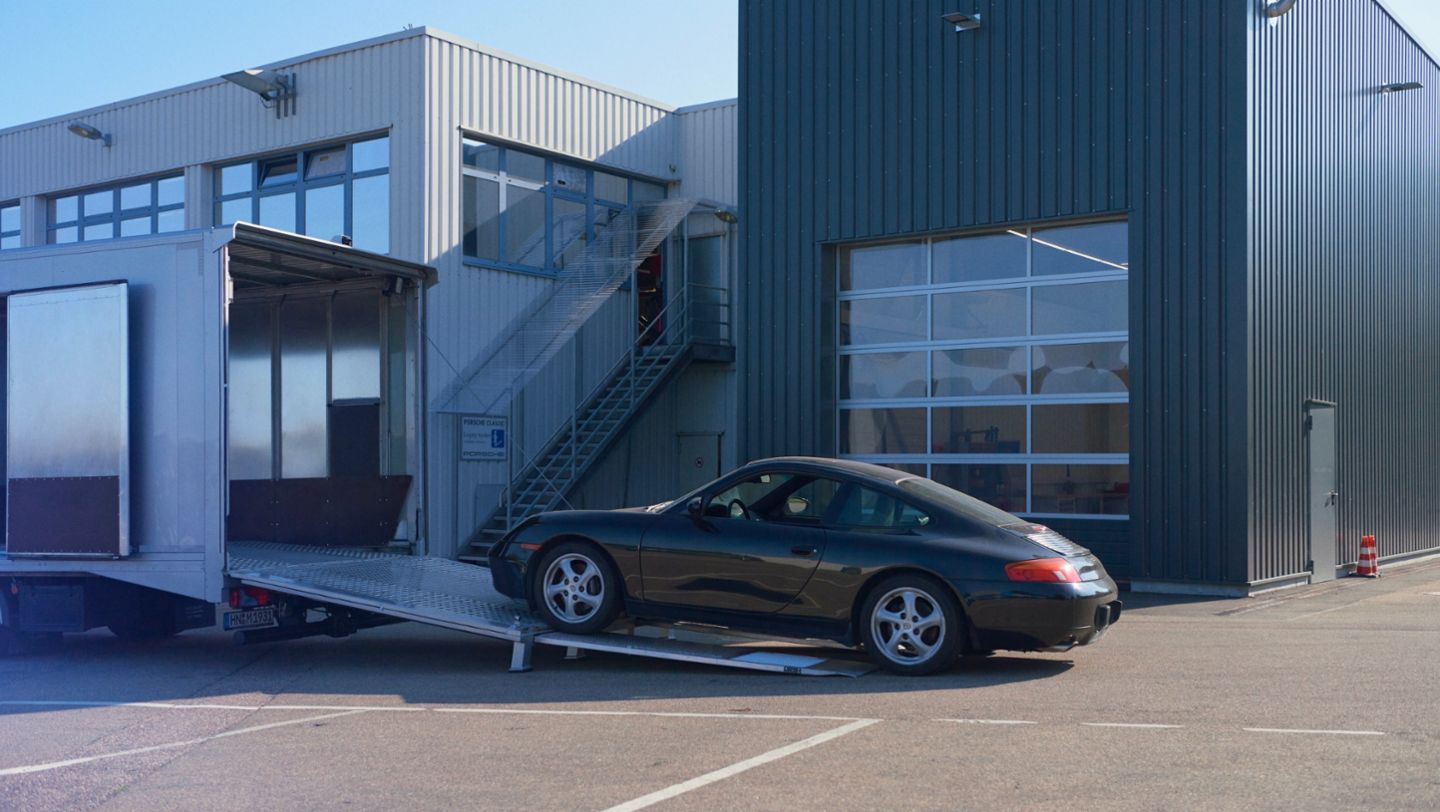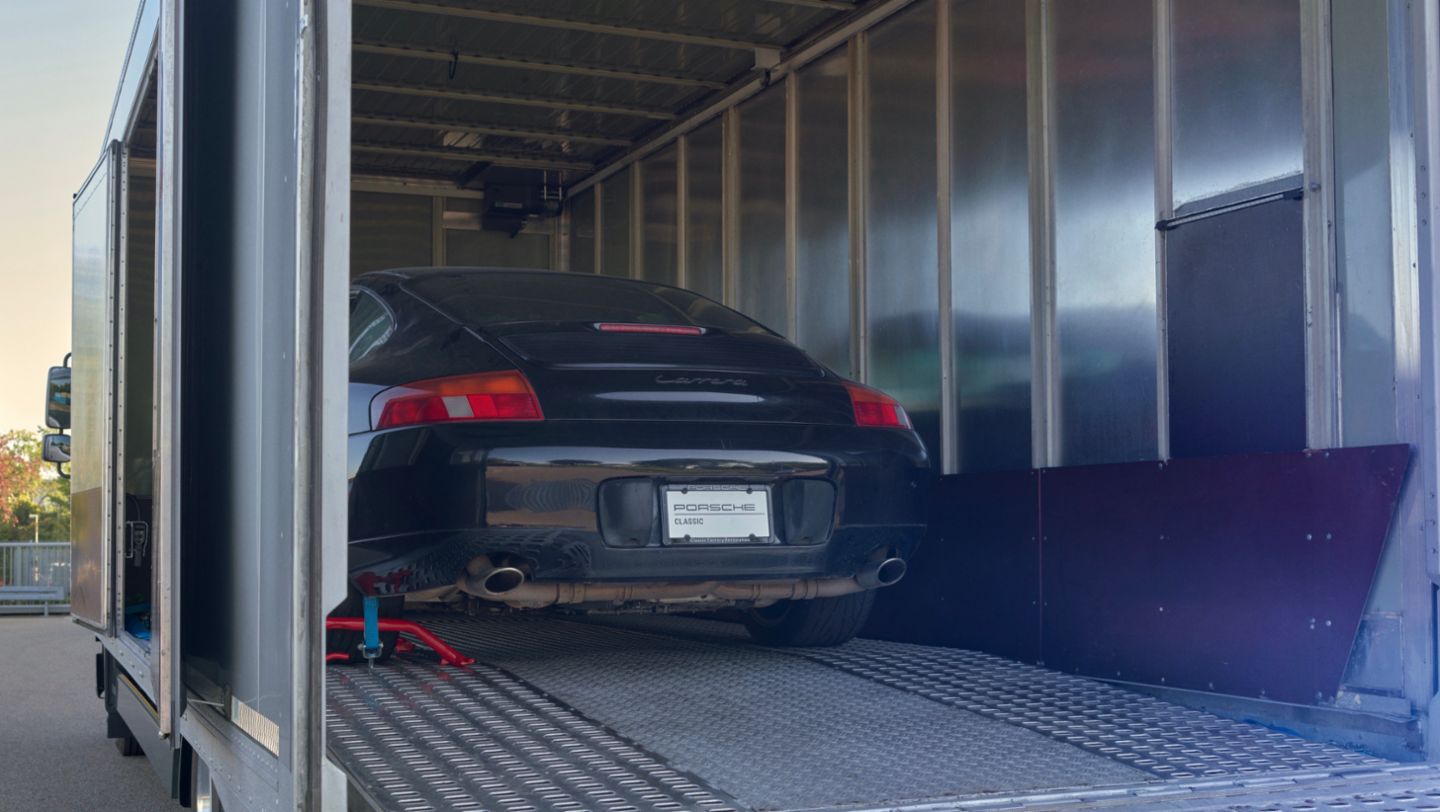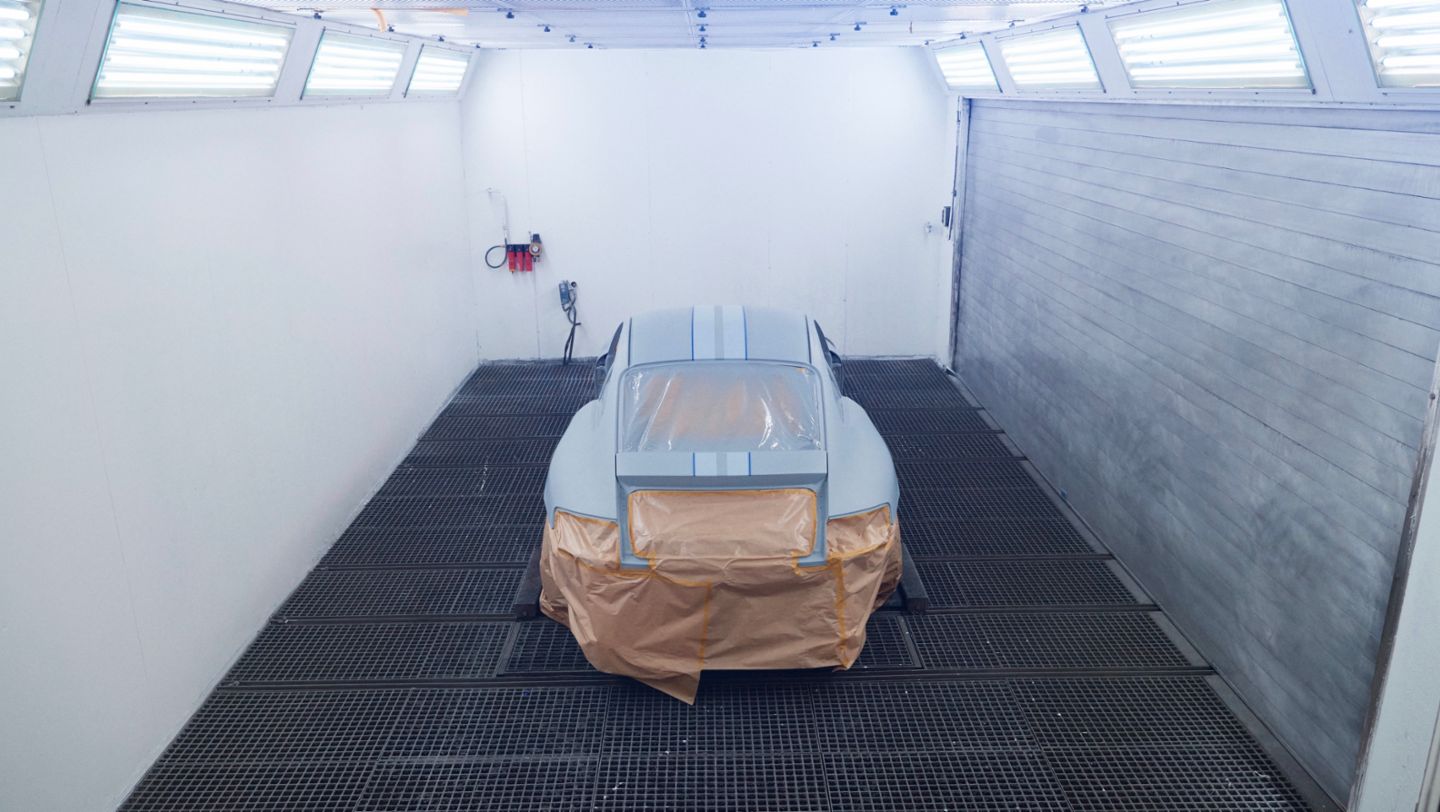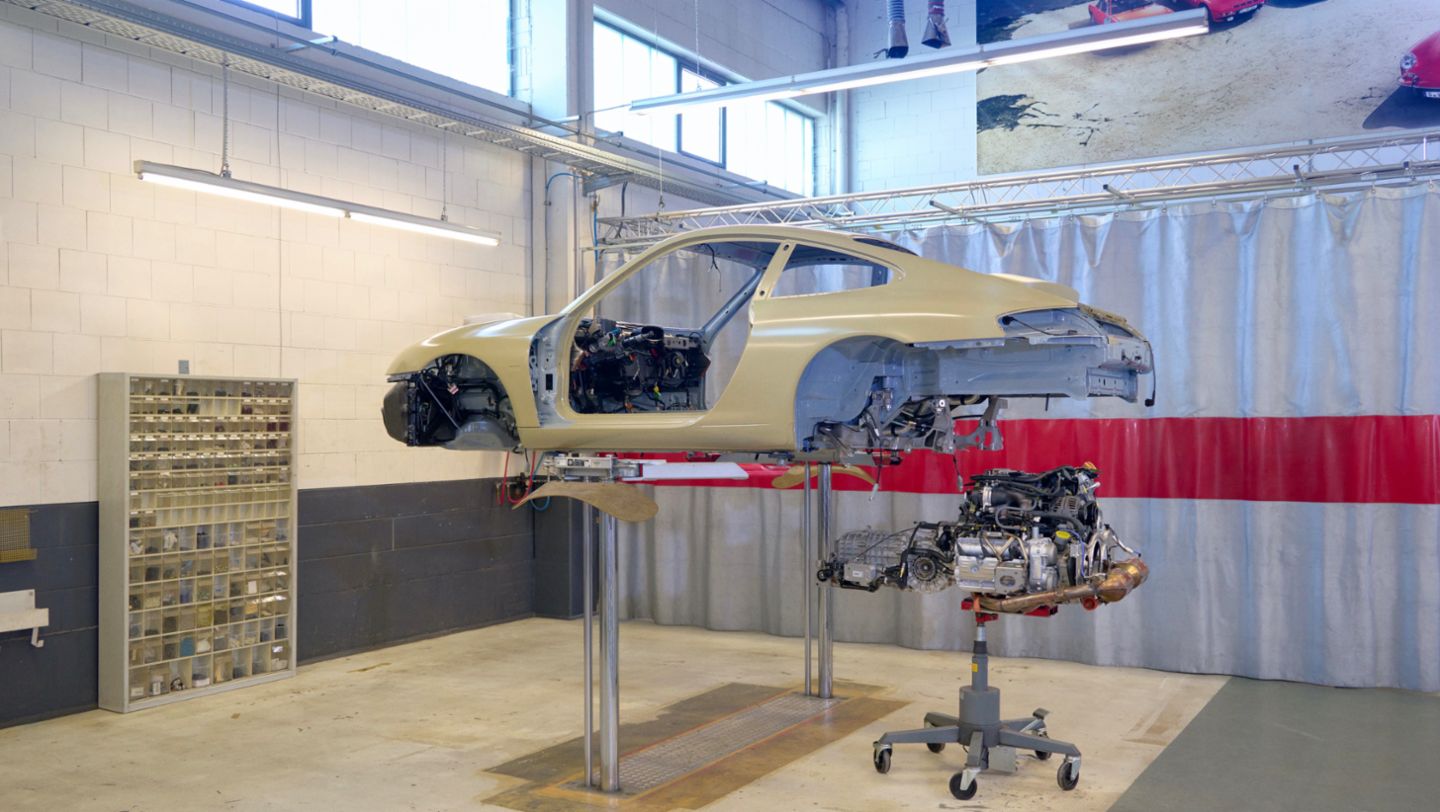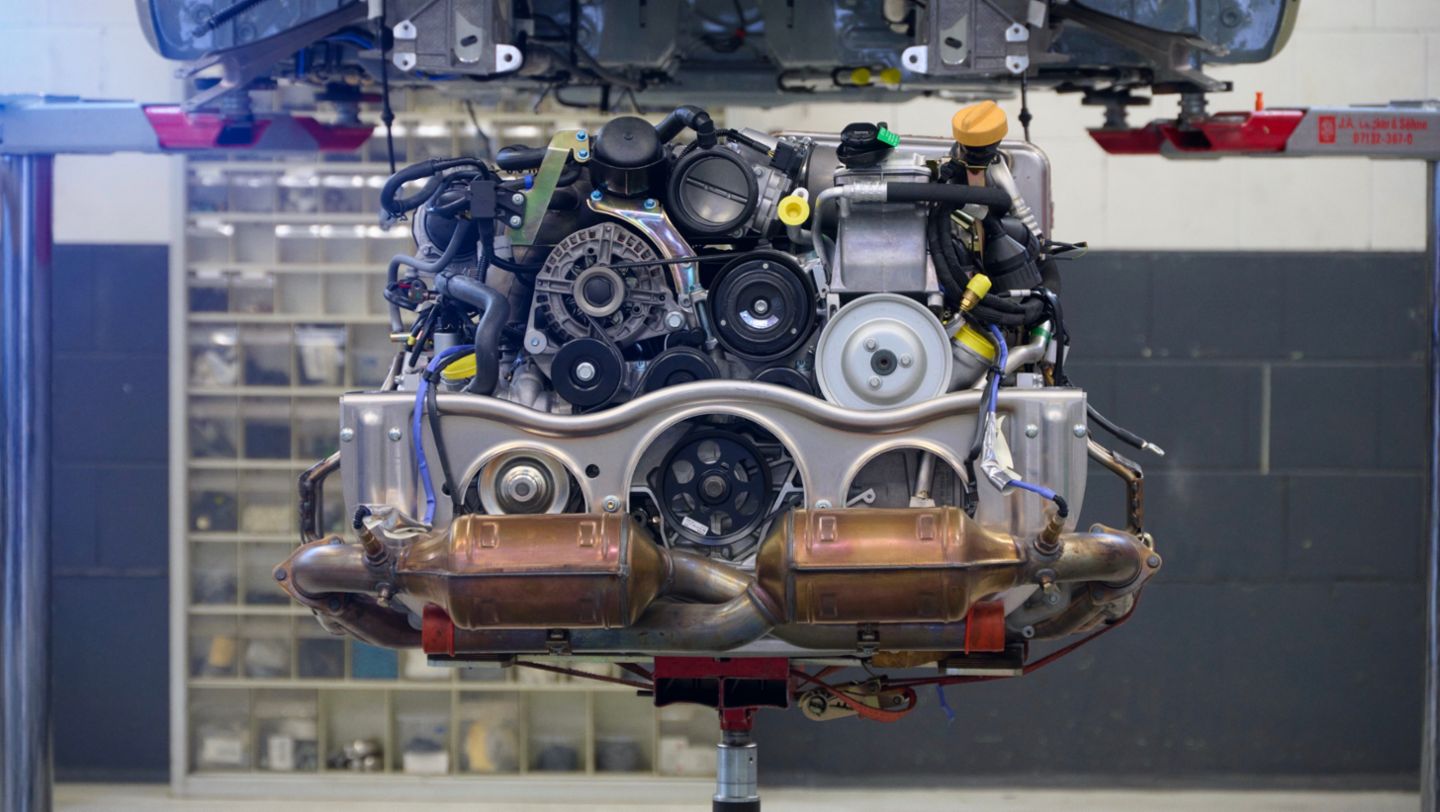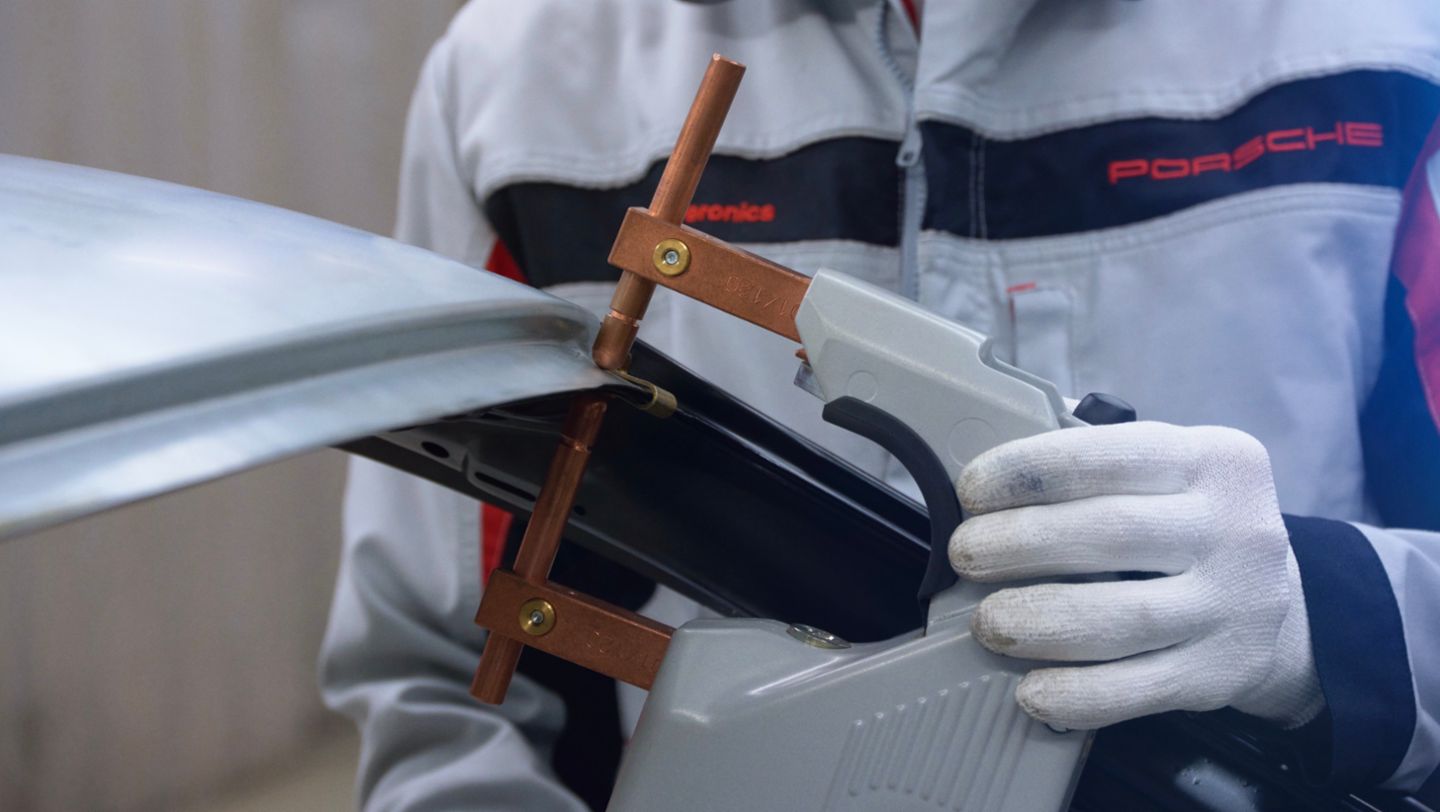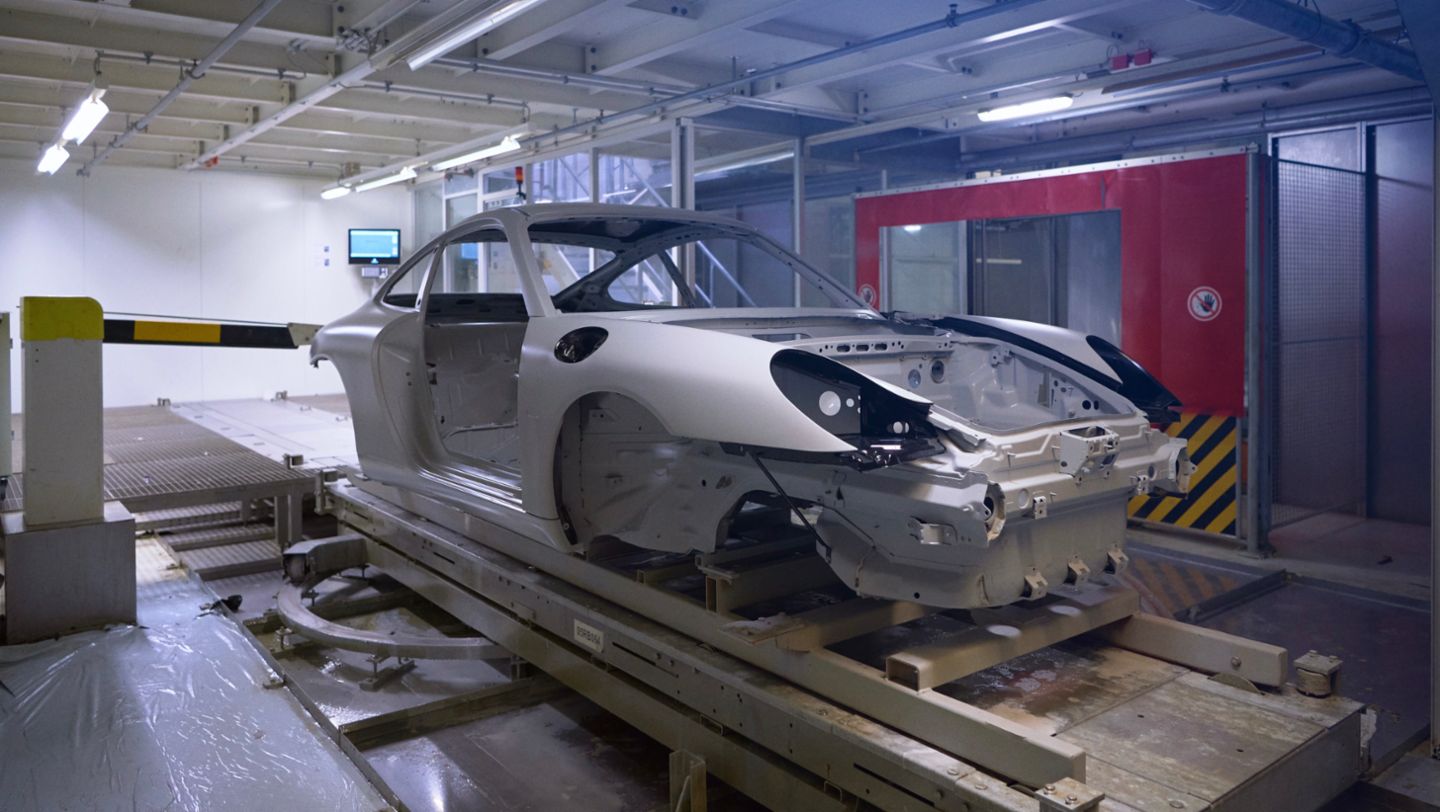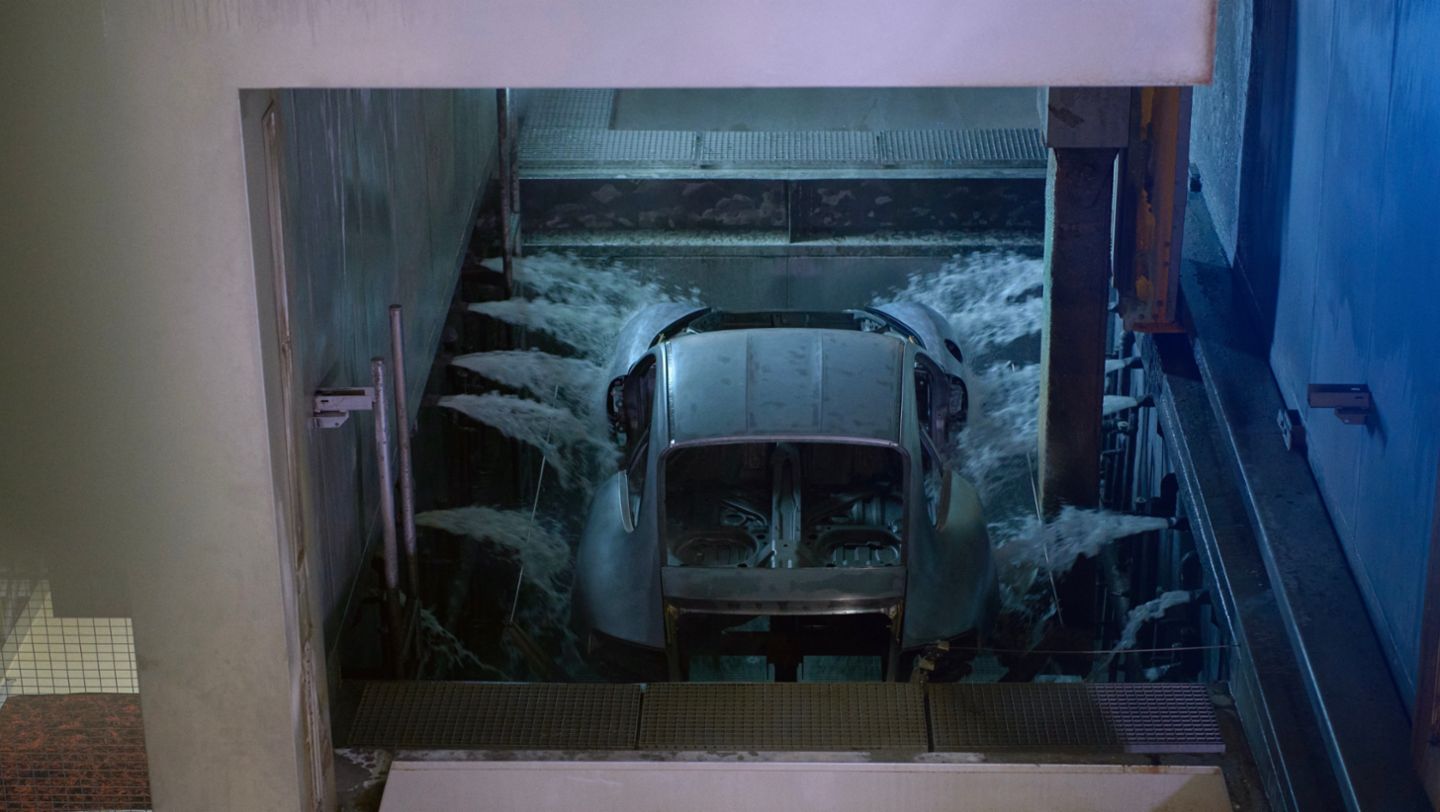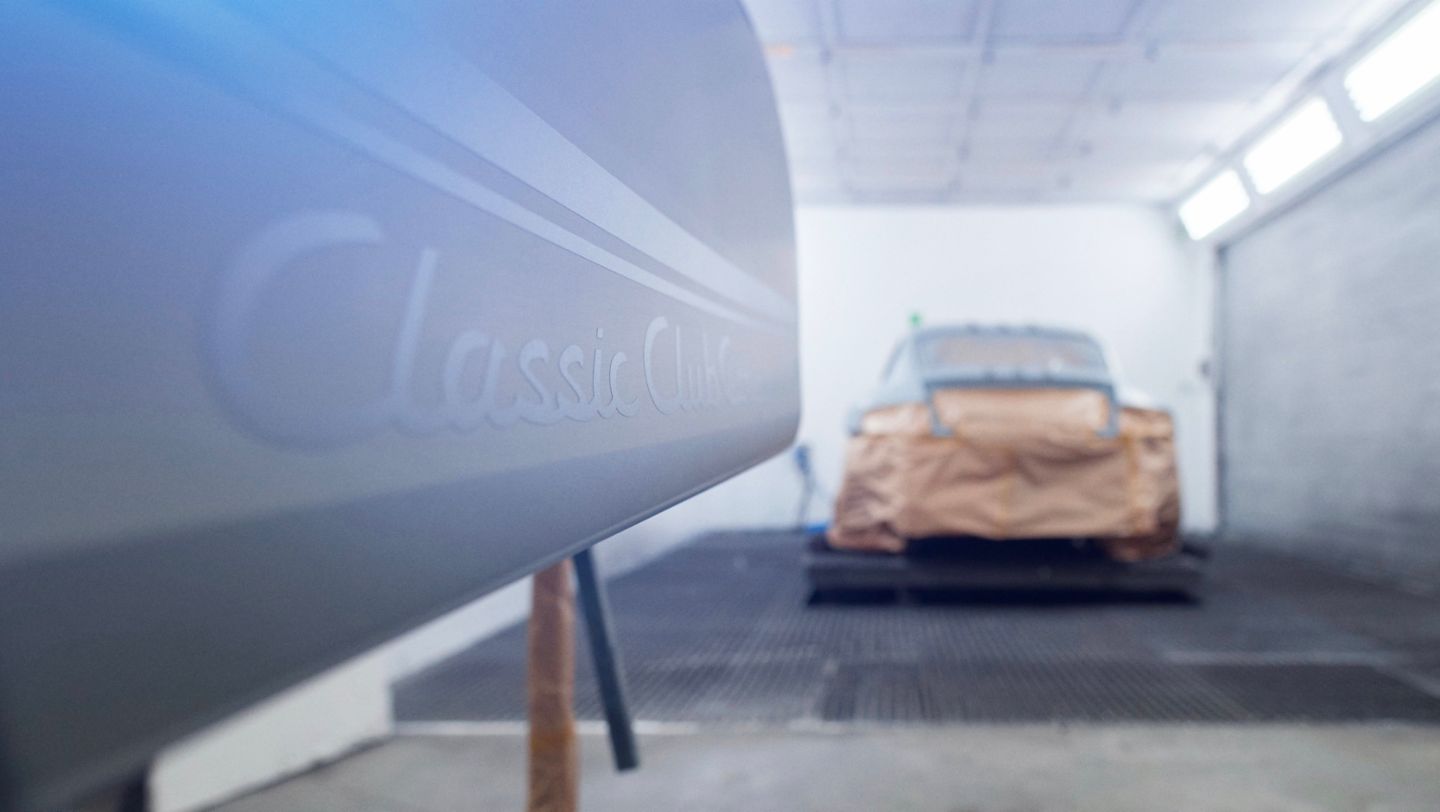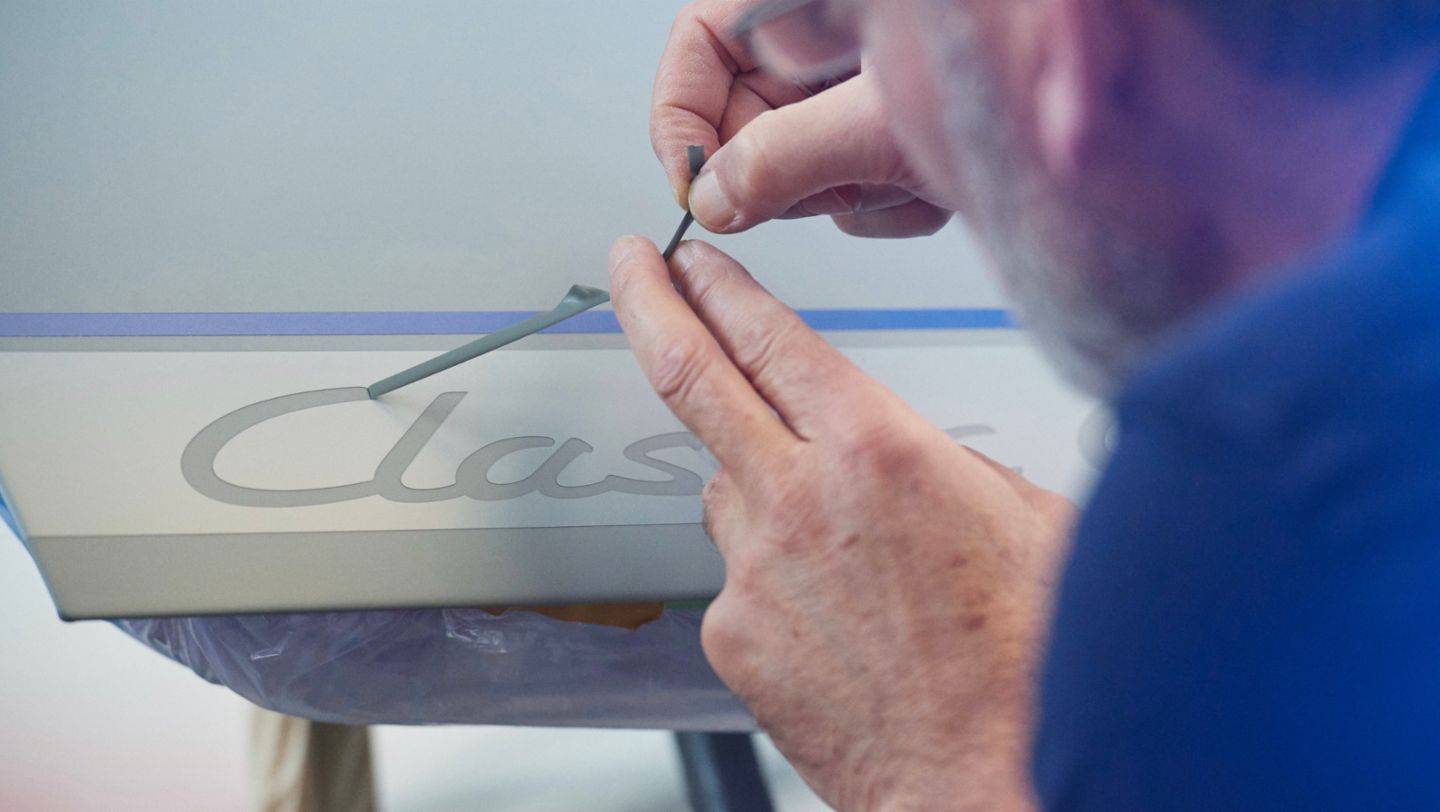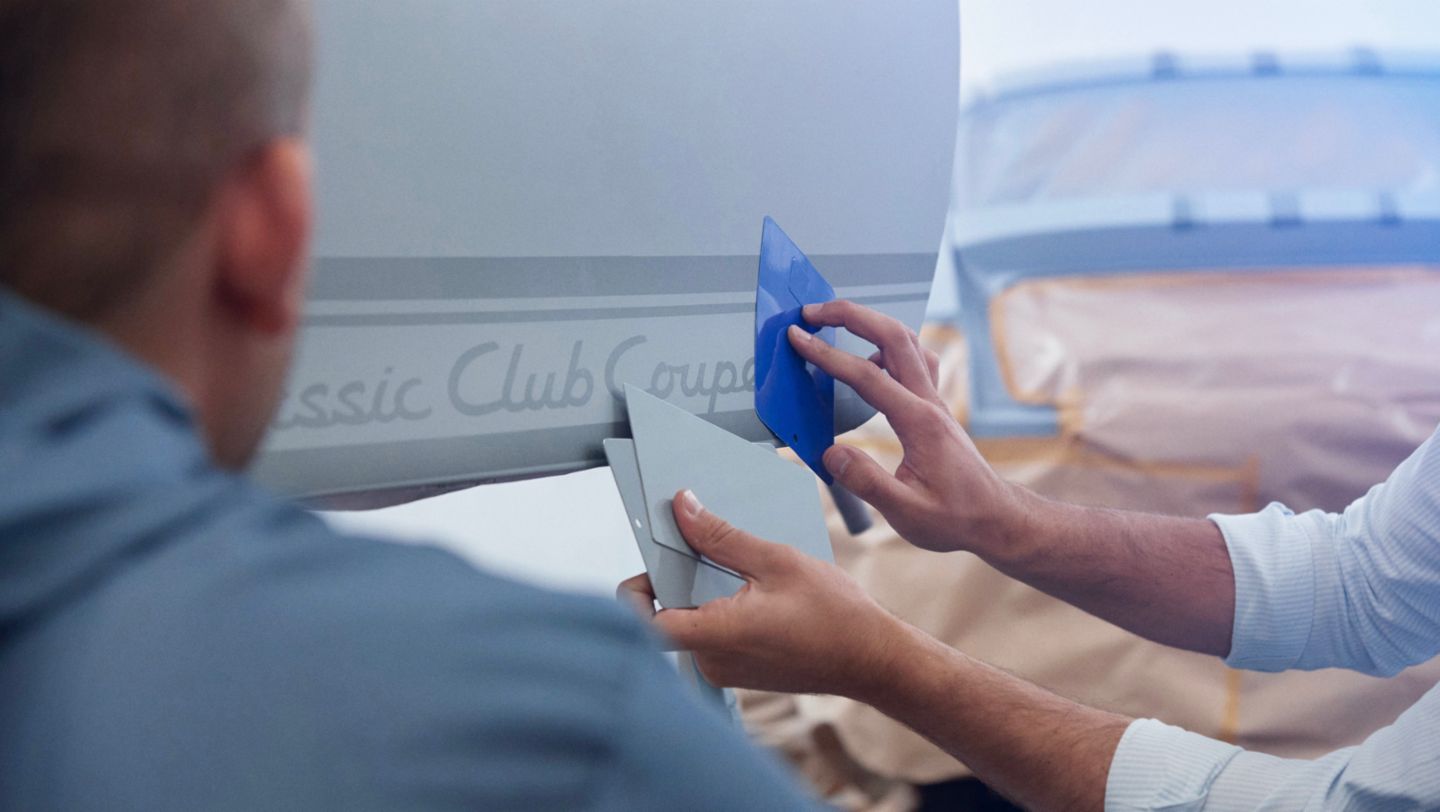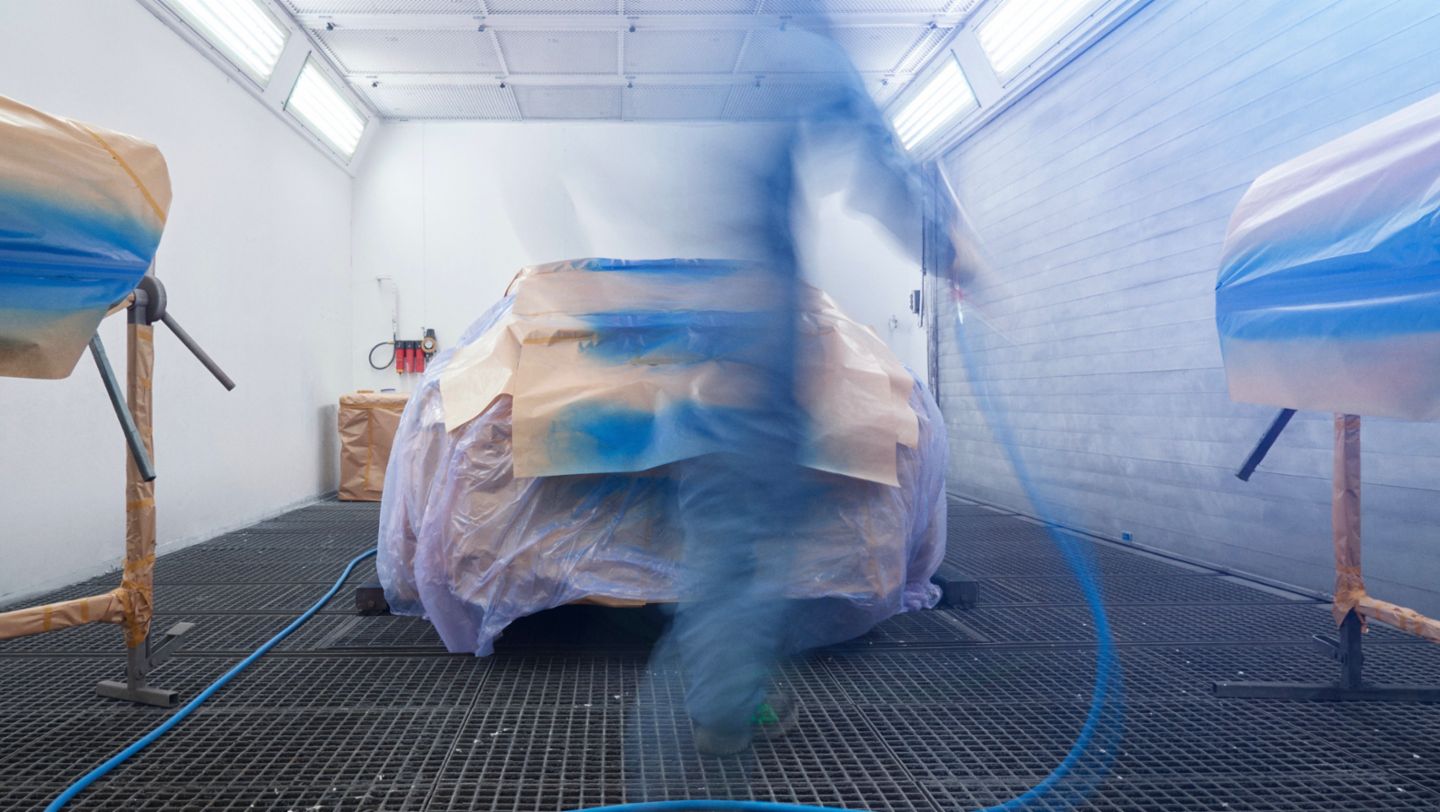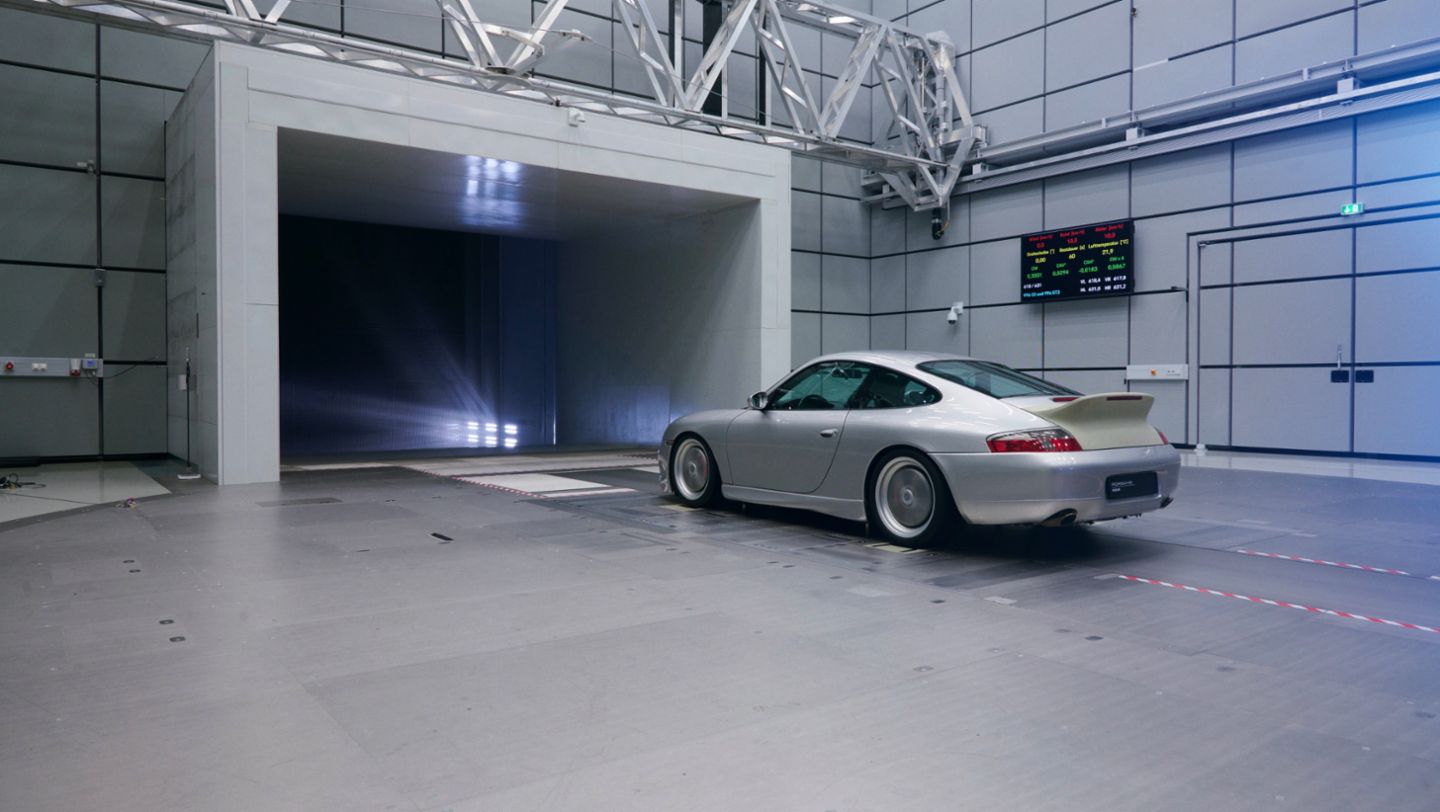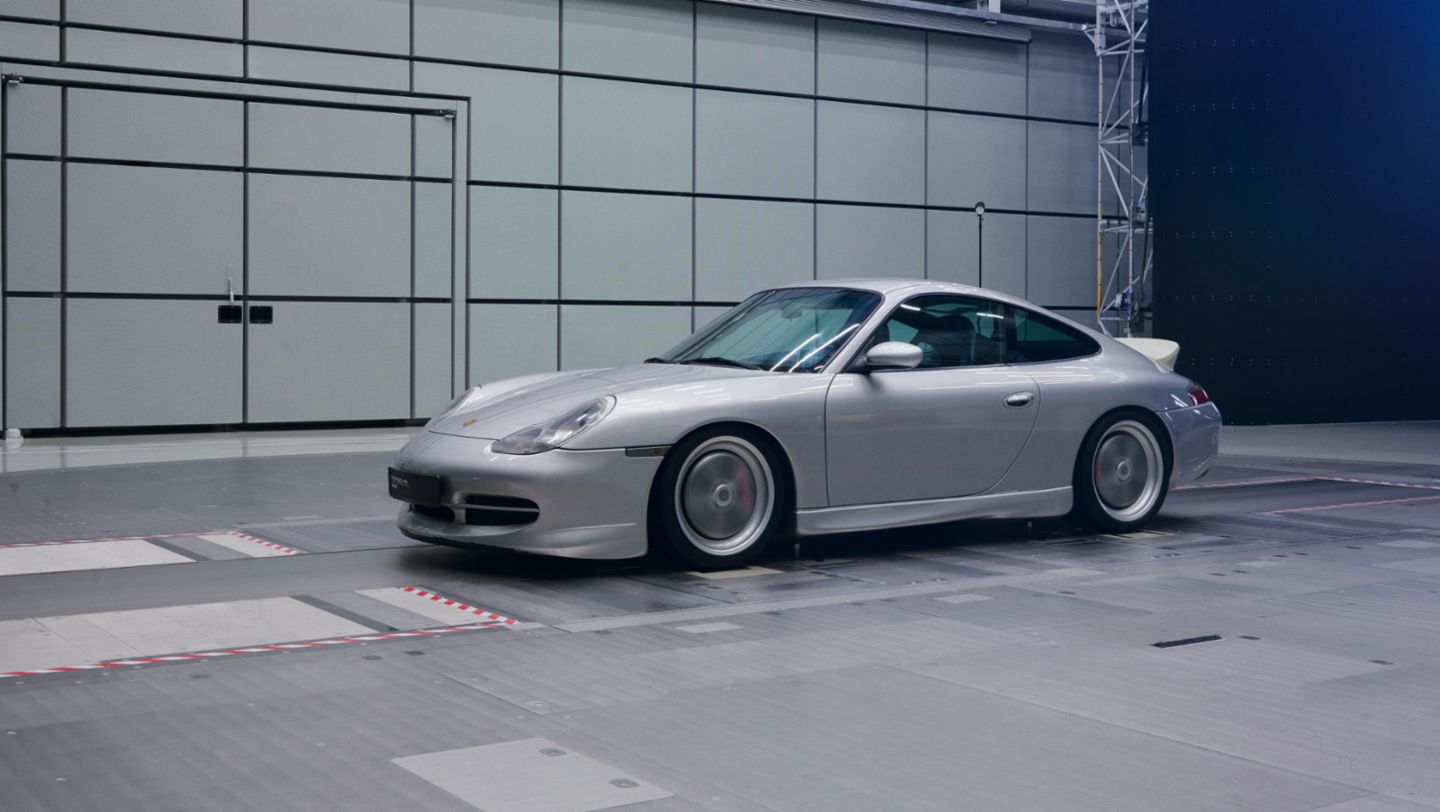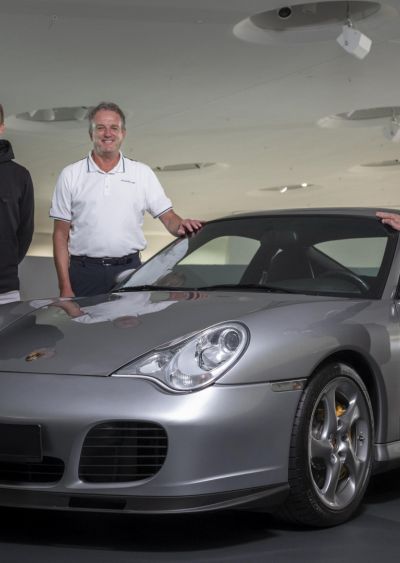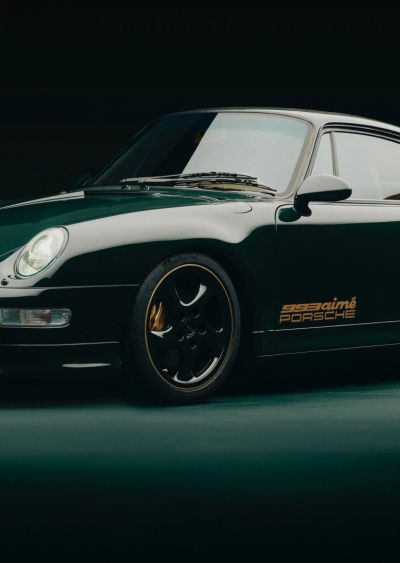In just two and a half years, a used 1998 911 Carrera (Type 996) was transformed into the Porsche 911 Classic Club Coupe, spelled the American way without an accent, because the car was made for the Porsche Club of America (PCA), the sport car brand’s oldest and largest club.
The vehicle’s special features include its Sport Grey Metallic paintwork, double-dome roof, Fuchs rims and fixed rear spoiler in the ducktail style of the 911 Carrera RS 2.7 from 1972. Many of the exterior and interior details are customised with PCA’s signature Club Blue. The centre sections of the sports seats, like the door panels, are made of intricate woven leather in a Pepita houndstooth pattern. Technically – and to some extent visually – the vehicle has also been converted to a second-generation 911 GT3 including the 3.6-litre engine from that model generating 280 kW / 381 PS. The chassis and brakes also come from the GT3 of that generation.
The idea for this unique factory car arose during a meeting between representatives of the Porsche Club of America and Alexander Fabig, now Head of Individualisation and Classic at Porsche, and designer Grant Larson of Style Porsche. To keep it secret, the vehicle was known internally as “Project Grey,” a nickname reminiscent of “Project Gold”, the 911 Turbo (Type 993) with an air-cooled engine that Porsche Classic built in 2018 from original parts. However, the main source of inspiration for the 911 Classic Club Coupe was the 911 Sport Classic (Type 997) presented in 2009. With Sport Classic Grey paintwork, a double-dome roof, ducktail and exclusive interior details, this limited series quickly gained cult status and has long been a sought-after collector’s item.
“The Type 996 is unjustly overshadowed by the other 911 ranges. That’s why we were happy to choose it as the basis for demonstrating all the things we can do with Porsche Classic and the recently expanded Sonderwunsch programme of Porsche AG,” says Alexander Fabig, Head of Individualisation and Classic. “In 2009, the 911 Sport Classic, a limited series of 250, had already generated worldwide interest. However, this special model was not sold in the US. With this one-off, we’ve now managed to bring a similarly exciting vehicle concept to the U.S. as well.”
“We wanted to work together to create something unique that would generate enthusiasm,” adds Tom Gorsuch, President of the Porsche Club of America (PCA). “The fact that the finished Porsche 911 Classic Club Coupe looks so sleek and natural is what’s really incredible about this challenging project.”
Exterior: Double-dome roof and ducktail are the stand-out features
The Porsche 911 Classic Club Coupe is painted in Sport Grey Metallic, inspired by the Sport Classic Grey of the 911 Sport Classic (Type 997). Twin stripes running across the bonnet, roof and rear spoiler create a particularly dynamic look. These are painstakingly painted in light Sport Grey, while on the 997 they were a foil trim that was darker than the body colour. Two fine lines in Club Blue mark the outline of the stripes. The side trim in the shape of a hockey stick is painted in light Sport Grey and bears the words “Classic Club Coupe” and a line in Club Blue.
The double-dome roof is also a detail with a motorsport connection. Tall racing drivers used to bulge the roofs to make enough headroom for wearing a helmet – the modern roof design alludes to this. The Style Porsche design concept 911 Panamericana from 1989, the Carrera GT and the 911 Sport Classic also had a roof shaped like this. Today, the double-dome roof is a classic design feature of many limited series from Porsche Exclusive Manufaktur and the 911 GT models. The fixed rear spoiler made of glass-fibre-reinforced plastic takes the shape of the legendary “ducktail” of the 911 RS 2.7 from 1972. The third brake light is built into it. The model designation “Classic Club Coupe” appears in the middle between the tail lights.
The unique car runs on 18-inch forged wheels whose cloverleaf shape immediately identifies them as legendary Fuchs rims. The spokes are painted in High-Gloss Black. Uniquely, the rim base has a Porsche logo and a thin line in Club Blue. The hub covers are adorned with a coloured Porsche crest. The brake callipers are painted Black and also have a Porsche logo in Club Blue. The mirror attachment piece is painted in High-Gloss Black. Both wings have inlaid “Classic Series” badges.
Interior: Pepita houndstooth woven leather on seats and door panels
The interior is sporty and sophisticated, and above all highly individual. This becomes clear as soon as you open the doors and see the “Classic Club Coupe” logo on the stainless steel door sill trims. Black leather dominates the interior in combination with slate grey, partially perforated Alcantara on the roof lining and pillars. The fact that the car is an absolute one-off is underlined by the “911 Classic Club Coupe No. 001/001” dashboard badge, mentioned earlier.
The centre panels of the sports seats, like the door panels, bear a Pepita houndstooth pattern woven from black and slate grey leather. Porsche first used intricately woven leather in the 911 Sport Classic (Type 997). What’s new here is that the Pepita look has been woven in a twill, which means that the fabric runs diagonally. Club Blue decorative stitching softens the classic look of the seats. “911 Classic Club Coupe” is embroidered in this contrasting colour in the headrests.
The standard three-spoke steering wheel that was fitted in the 996 has been upgraded in the same way, with Club Blue thread and leather used for the decorative stitching on the rim and the 12 o’clock mark. The round instruments are customised in a similar way to the 911 Sport Classic. The rev counter, for example, has two grey stripes with lines on the sides in Club Blue and the “911 Classic Club Coupe” logo. The Porsche Classic Communication Management Plus (Sirius XM-ready) infotainment system with Apple CarPlay and Google® Android Auto is also on board. By special request, the start screen on the seven-inch display was changed to show the vehicle designation “Classic Club Coupe”.
Selected accessories from the Porsche Classic product range have been modified in terms of the material or craft methods used, making them unique to match the special status of “Project Grey”. These include the custom-made car cover, the vehicle key in the car colour with a leather case, and the tool bag made of woven leather in a Pepita houndstooth pattern. A touring bag is also included.
How a used car was given a new lease of life
The base vehicle is a black 911 Carrera, built in 1998. Neglected and in poor condition, it was parked at a dealership in Columbia, Virginia, where PCA executive director Vu Nguyen found it.
The start of its second life began with a flight across the Atlantic. The 996 was transported to its home country and taken to the Porsche Classic workshop near the main plant in Stuttgart-Zuffenhausen. As with a full restoration, the experts completely disassembled the vehicle. Inspired by the GT3, the bodyshell was rebuilt and strengthened using new original parts as well as newly developed components. For the chassis, as well as the brakes and powertrain, in other words the engine and manual transmission, the experts opted for second-generation components that were also available in the US.
The design was carried out simultaneously to the restoration of the vehicle. The experts from Porsche Individualisation and Classic and from Style Porsche drew up proposals and regularly discussed them with the PCA. Naturally, the most intensive adaptation work took place on the special features of the 911 Classic Club Coupe: the double-dome roof and the fixed rear spoiler. This meant the part of the body between the rear window and ducktail had to be handmade. The biggest challenge in the interior, on the other hand, was to harmonise the strengths of the new material with the geometry of the surfaces in the 996’s interior. This was where the many years of expertise of a saddler proved their worth.
Standing in for the valuable one-off, a test vehicle went through extensive trial runs at test sites including Weissach in Germany, Nardò in Italy and Idiada in Spain. These included endurance runs at top speed. However, the test vehicle was dismantled, ensuring the final product is truly a one-off. The technical modifications to the 911 Classic Club Coupe were evaluated by a team of experts from Porsche Individualisation and Classic, Porsche Cars North America and the Porsche Development Centre in Weissach. The aerodynamics were tuned in the wind tunnel. The overall vehicle was approved after a road test by the Porsche Development Centre in Weissach.
About the Porsche 911 Type 996 (1997 – 2006)
In 1997, with the Type 996, the fifth generation of the 911, Porsche converted the engines from air to water cooling in order to be prepared for increasingly stringent emissions regulations. In the Type 996, the 3.6-litre naturally aspirated engine of the 911 GT3 initially produced 360 PS, and later 381 PS. The body was completely new and unprecedentedly sleek. The unusual shape of the front headlights was as characteristic as it was polarising. The interior benefitted from the larger exterior, so that the 996 offered more elbow room and a more spacious feel than its predecessor. The dashboard also had a new look, with the five circular instruments linking into each other. Between 1997 and 2006, Porsche produced a total of 175,262 Type 996 vehicles. Porsche Classic takes over responsibility for vehicles ten years after their end of production. This means the experts are currently already looking after the Type 996.
About Porsche Classic
Porsche Classic aims to preserve and maintain legendary vehicles and the latest classics. Decades of experience with classic Porsche vehicles make the experts the right contacts when it comes to original parts, restoration and repair. The first point of contact for customers with historic Porsche vehicles are the, currently 78, certified Porsche Classic partners worldwide, including four Porsche Classic centres. As part of its Co-Creation strategy, Porsche is reinterpreting its legendary Sonderwunsch programme from the late 1970s, which will enable it to design customised, one-off cars. Depending on the age of the vehicle in question, either the technical experts at Porsche Exclusive Manufaktur or the specialists at Porsche Classic will take care of implementation.
About the Porsche Club of America (PCA)
The PCA is one of the sports car brand’s oldest and largest clubs. Founded in 1955, it now has over 145,000 members and is represented in 147 regions in the US and Canada. Members showcase their Porsche vehicles at exhibitions and race against each other. The PCA organises rallies, autocross events and tourist trips. In addition, the club sponsors driver training, supports restorations and helps with technical issues.
Article republished from Porsche News Room
